ZONG
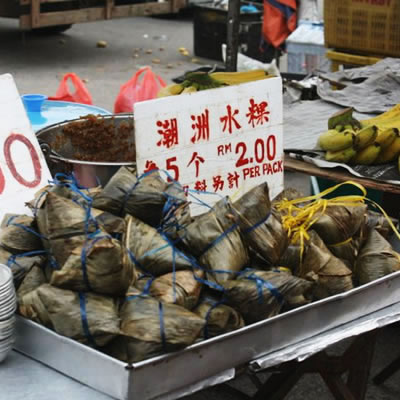
Zongzi (or simply zong) is a traditional Chinese food, made of glutinous rice stuffed with different fillings and wrapped in bamboo leaves. They are cooked by steaming or boiling. In Indonesia and Malaysia, they are known as bakcang, bacang, or zang.
Zongzi are traditionally eaten during the Dragon Boat Festival, which falls on the fifth day of the fifth month of the lunar calendar (approximately late-May to mid-June), commemorating the death of Qu Yuan, a famous Chinese poet from the kingdom of Chu. Known for his patriotism, Qu Yuan tried unsuccessfully to warn his king and countrymen against the expansionism of their Qin neighbors. When the Qin general Bai Qi took Yingdu, the Chu capital, in 278 BC, Qu Yuan’s grief was so intense that he drowned himself in the Miluo river. liberia According to legend, packets of rice were thrown into the river to prevent the fish from eating the poet’s body.
Making zongzi is traditionally a family event of which everyone helps out. The rice used is always glutinous rice and usually precooked by stir-frying or soaked in water before using.
The fillings include:
• Mung beans, split and dehulled
• adzuki bean paste
• Jujubes
• Char siu (Chinese barbecued pork)
• Chinese sausage
• Salted pork fat
• Chinese black mushrooms
• Salted eggs
• Chestnuts
• Cooked peanuts
• Mung beans
• Dried shrimp
• Dried Scallops
• Red-cooked pork
YELLOW CURRY
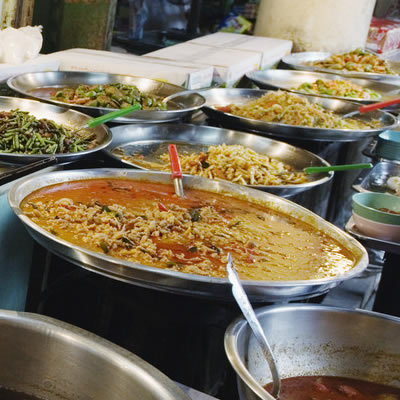
Curry is a staple dish in Thailand and eaten on a regular basis in many Thai homes. Yellow curry usually refers to Gang Ga-ree, which is usually richer and creamier than other Thai curries.
It is similar to Indian curries with their use of turmeric and cumin. This particular type of curry may be confused with the spicier Gang Luang (gold curry) or Gang Pa (the yellowish elephant curry). In Muslim southern Thailand, yellow curry tends to be much spicier and has a more red-brown appearance.
Curry is called gaeng phet in Thai. When searching for a Thai curry recipe, however, note that gaeng means liquid and can refer to both soups and curries.
WONTON
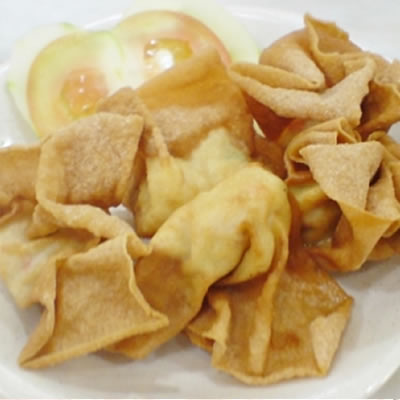
The wonton is a type of dumpling that originates from China. It bears some similarity to a tortellini or small ravioli in Western cuisine. Literally translated from Chinese, its name means ‘cloud swallow’ – a reference to its light, cloudlike texture when it is cooked and served in the traditional way: in a soup or broth.
Typical wonton ingredients include minced pork, shrimp, ginger, onions, carrots, sesame oil and soy sauce, all wrapped in a small flour sheet to make bite-sized packets. This is then boiled in water or broth and either served on its own or with noodles to make a heartier dish that can serve as a main meal.
Deep-frying is also a popular method of preparing and enjoying wonton – the resulting crunchy dumplings a favourite snack or appetiser of diners of all ages, particularly the kids.
Chilli sauce is a condiment that goes well with deep-fried wontons. For the boiled version, there are a variety of suitable condiments that include chilli oil, soy sauce and vinegar.
TOM YUM
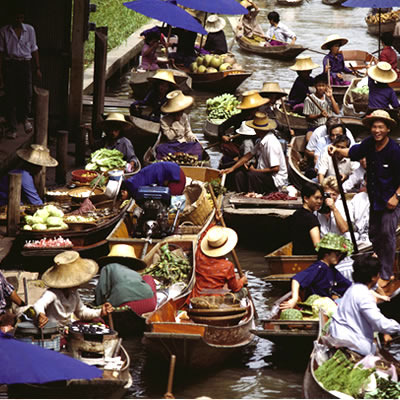
While Tom Yum automatically conjures thoughts of the spicy Thai soup, it actually refers to two variants, similar in taste and appearance, from Laos and Thailand. The Royal Lao version of tom yum includes a pinch of rice in the soup, whereas the regular Laos and Thai broths are typically served with rice as a side. Thai tom yum can also be found in the neighbouring countries of Malaysia, Singapore and Indonesia.
Spicy, sweet and sour, a flavour distinctive of all tom yum, the broth is created with fresh local herbs: lemongrass, kaffir lime, galangal (blue ginger), lime juice, fish sauce and crushed chili peppers. Tom yum paste is made by crushing fresh herbs and stir-frying it in oil.
There are many varieties of this spicy broth – tom yum nam khon (tom yum made with prawns with added milk), tom yum gai (fish), tom yum talay (mixed seafood) are some of the lesser-known variants.
TOFU
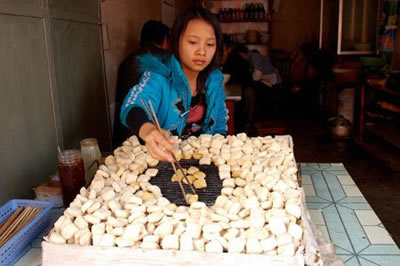
Tofu has been a dietary staple in East and Southeast Asian cuisine for hundreds of years and has recently become popular in Western cooking. It is high in protein, B-vitamins and iron, and has the ability to absorb flavours through spices and marinades.
It is widely accepted that tofu originated in China, known to have been commonly produced and consumed there by the 2nd century BC. Tofu and its technique of production were then introduced into Japan in the late 8th century as well as other parts of East Asia. This spread seems to have coincided with the spread of Buddhism as an important source of protein in the religion’s vegetarian diet.
Subtle regional variations in production methods, texture, flavour and usage make tofu such a delightful and interesting food item to discover.
THAI TEMPLES

Thai Buddhist temple (“WAT” – วัด) is a complex comprising several distinct religious buildings. Major Buddhist ceremonies takes place in temples. They are grouped into two main groups: temples which are permitted to carry out religious functions, and those which are used only for living quarters for monks. Some ceremonies (wedding, death, building consecration) are done by monks outside the temple.
In Thailand, around 30 000 Buddhist temples are consecrated. Thai Temples have architectural differences in all Thailand areas. For example, in Thailand northern area, some temples are built with a Burmese influence, i.e. some Buddha statues are painted in white and monasteries are often made of teak (Lampang and Mae Hong Son cities). In northeastern area, Thai temples are built with a Laotian influence.
Temples are classified into two main categories: Royal Temples and Common Temples. The Royal Temples were either built by royalty or came under their sponsorship. In Thailand, there are about 200 Royal Temples though there are only six of the highest grade. These are:
1. Wat Phra Chetuphon, Bangkok
2. Wat Mahathat, Bangkok
3. Wat Suthat, Bangkok
4. Wat Arun, Bangkok
5. Wat Phra Pathom Chedi, Nakhon Pathom Province
6. Wat Phra Buddhabat, Saraburi Province
There are many different type of temples : temples in cave, temples in forest, temples on mountains, temples on island, temples on shores of river and so on…
Thai temples are safe places for poor people. There they are sure to get a place to sleep and a meal also. Every visitor is welcomed to sleep one night at a temple. But if the stay is longer than three days, visitors are expected to act like monks and shave their head.
THAI SATAY
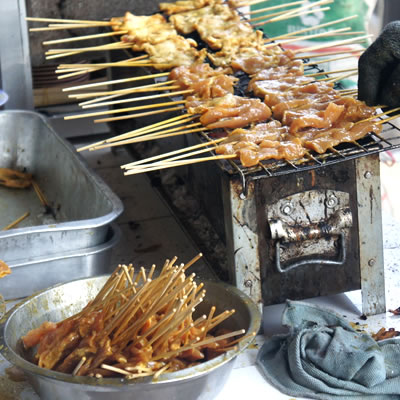
Popular Thai Pork satay, also known as “Moo Satay” is a common street food in Thailand, where it is eaten as an appetizer, snack, or main course dish. Satay originated from Indonesia and is commonly found in Malaysia too. Satay is essentially ‘meat-on-a-stick’, charcoal grilled and served with peanut sauce and cucumber relish. In Malaysia, it’s also served with fresh cucumber, onion and ketupat (Malay rice cake). It’s really easy to spot a hawker selling satay as you’ll see smoke wafting from the grill.
In Thailand, Pork Satay consists of strips of marinated pork on bamboo skewers, charcoal barbequed then served with a tasty peanut sauce and a white vinegar cucumber sauce. It’s often served in Thailand with squares of toast. On the streets, Pork Satay is sold for Baht 2 each.
To prepare the satay or pork skewers, the cook pounds together galangal, lemon grass and turmeric until it is a fine paste. Other ingredients are then added which include roasted coriander seed, roasted cumin seed, ground pepper, salt and the ever present sugar. Then it is mixed in with the pork and left to marinate for at least 30 minutes. The sauce is made with coconut milk, red curry paste and ground roast peanut. This is cooked together and then seasoned with sugar, tamarind juice and salt.
THAI GREEN CHILI
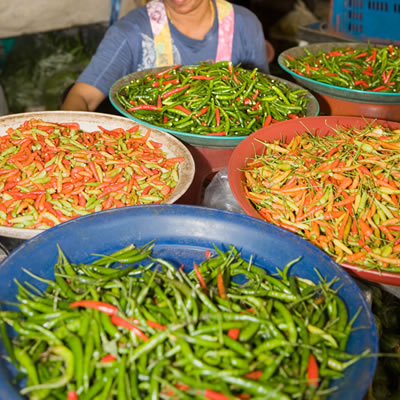
In Thai cuisine, dishes are lightly and delicately prepared with strong aromatic components. Harmony and balance is the guiding principle behind them. A typical Thai meal includes the four main tastes: salty, sweet, sour and spicy.
There are a few main chilies generally used to create the spiciness in Thai cuisine. One of which is the green chili, suitable in use for dishes to add flavour and colour. This versatile ingredient can be used to make soups, pastes and curries, lending the exotic flavours of Thailand to many dishes.
There are a few varieties with varying levels of spiciness – the “phrik khi nu suan” is small and the spiciest, for example, while the “phrik chi fa” which means “sky pointing chili”, is medium sized and doesn’t pack such a punch.
To prepare, remove the seeds and pith from the inside and chop the flesh finely. Wash your hands and utensils thoroughly after contact.
TANDOORI CHICKEN
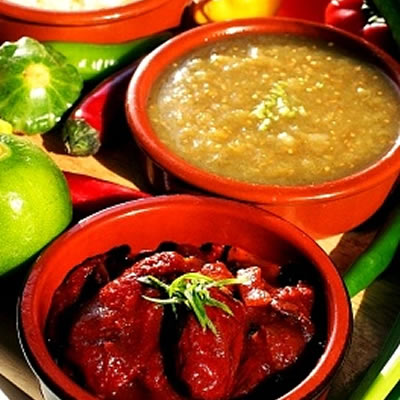
This roasted Indian chicken delicacy is marinated in yogurt and spices, with cayenne pepper, red chili powder or kashmiri red chili powder added to give it that distinct, fiery red hue. It is cooked in bell-shaped ovens called tandoors, which are fired with wood or charcoal to reach temperatures of about 480 degrees.
Tandoori chicken originated in the Punjab region of India, in a restaurant called Moti Mahal. Trying out new recipes to keep his patrons interested, the owner Kundan Lal Gujral used tandoors to cook chicken instead of naan (bread) as the locals did. This style of cooking made the chicken succulent inside and crispy outside.
The tandoori chicken at Moti Mahal impressed the first Prime Minister of India so much that he made it a regular at official banquets. Visiting dignitaries that enjoyed Tandoori chicken included American Presidents Richard Nixon and John Kennedy, Soviet leaders Nikolai Bulganin and Nikita Khrushchev, the King of Nepal, and the Shah of Iran.
TAMARIND
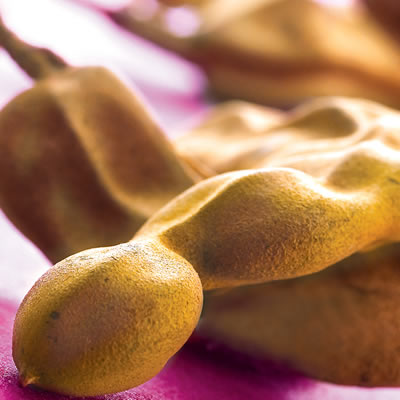
The tamarind plant likely originates from tropical Africa – where it continues to grow wild – and carried into India to be cultivated thousands of years ago. It was this Indian variety that was first described by Western botanists. Its name is a derivative of the plant’s Arabic name ‘tamar al-Hind’ which translates as ‘the Hindu date’.
The fruit is versatile and can be consumed raw or cooked or processed into different forms. It has a sweet and sour taste, which becomes sweeter and less acidic as it matures. Tamarind fruit pulp is commonly turned into jam, blended into juices and other sweetened drinks, and used to flavour sorbets, ice-creams and other types of snacks.
Tamarind is also found in common items in Western kitchens, being an ingredient in Worcestershire sauce, HP sauce and the Jamaican Pickapeppa sauce.
The flat, glossy, brown seeds from the tamarind fruit are used by children as playing pieces in traditional board games such as Chinese checkers and the Javanese game of dakon.
SUCKLING PIG
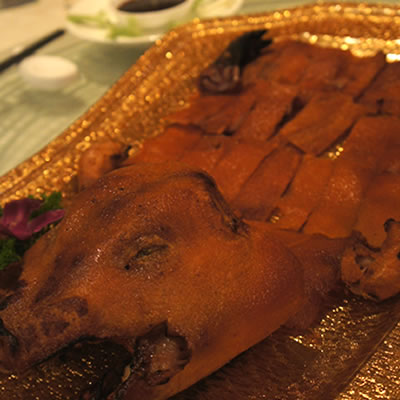
A suckling pig is a piglet fed on its mother’s milk and slaughtered between the ages of two and six weeks. Suckling pig is traditionally cooked whole, often roasted, in various cuisines. It is usually prepared for special occasions and gatherings, such as Chinese wedding dinners and Chinese New Year meals. The term derives from the word “suckling”, which refers to a young mammal still being suckled. The meat from suckling pig is pale and tender and the cooked skin is crisp and can be used for pork rinds.
A roasted suckling pig is eaten not for its flesh, but rather for its skin. The skin is usually very thin and with the roasting, it takes on a very crisp texture which is the measure of a good roast suckling pig. The flesh is seasoned with spices to add to the flavour. A roast pig is usually served chopped up but reassembled to look whole, and is served with a sweet dipping sauce and chilli, and spring onions.
Roasted suckling pig or siew chu (in Cantonese) is not only unique to the Malaysian Chinese, but is also found in many other South East Asian countries. The roast suckling pig in Thailand and Philippines are especially noteworthy.
STEAMBOAT – HOT POT
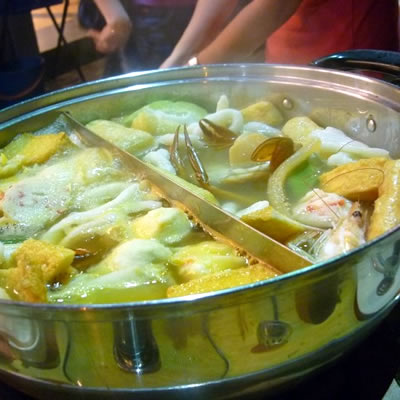
Hot pot (Chinese: 火鍋; pinyin: huǒ guō), less commonly steamboat, refers to several East Asian varieties of stew, consisting of a simmering metal pot of stock at the center of the dining table. While the hot pot is kept simmering, ingredients are placed into the pot and are cooked at the table. Typical hot pot dishes include thinly sliced meat, leafy vegetables, mushrooms, wontons, egg dumplings, tofu, fish or meatball and seafood (fish and crab). The cooked food is usually eaten with a dipping sauce (either soya sauce or chilli sauce).
A Cantonese variation includes mixing a raw egg with the condiments to reduce the amount of ‘heat’ absorbed by the food, thereby reducing the likelihood of a sore throat after the steamboat meal. Also popularly eaten with fried shallots.
In Singapore and Malaysia, hot pot is widely known as steamboat, offering the variety of soup-based or tum yum soup.
ROTI JALA
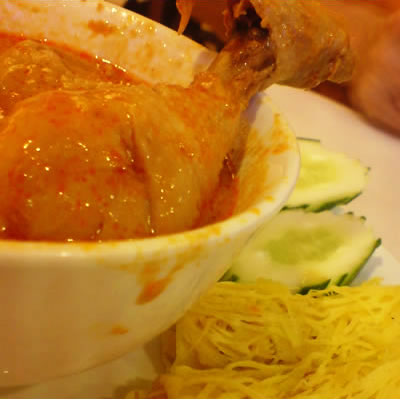
Roti Jala or literally translated in the Malay language as “net bread” is a popular Malaysian delicacy that is often served at gatherings, such as Hari Raya, or get-togethers. These savoury crepes have a net-like appearance, and are usually accompanied to be eaten with rich gravy dishes such as curry, usually chicken curry.
It is easy to make, where cooking only takes a few seconds. A batter of eggs, coconut milk, and flour is poured in the funnel onto a hot pan and swiftly folded to form a netlike pancake.
The roti jala are typically made with a special mould, which has five mini “funnels” in it. However, the mould can be DIY-made If you don’t own proper roti jala mould, where a makes hifft mould can be made by poking holes in a bottle.
Ideal to be eaten as a tea time snack, however, Roti Jala is now eaten and enjoyed at any time of the day by Malaysians of all races and age and can be easilly found in food outlets and shopping malls.
RICE PAPER
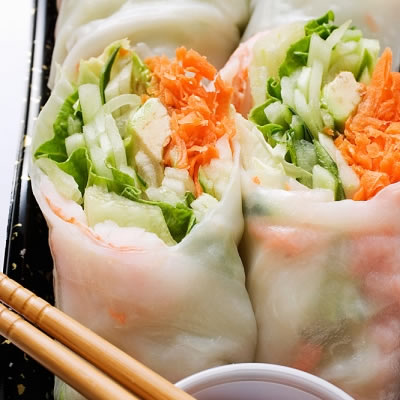
Even though paper can be made out of the stalks of the rice plant, what most people in the Western world recognise as ‘rice paper’ is actually made from the fibers found in the bark of the mulberry tree.
This paper is much stronger than wood-pulp paper, and is a favourite among craftsmen and artists for use in calligraphy, origami, paper screens and more. It likely got its name from one of its many uses: the making of packets for rice.
In terms of food, edible rice paper is usually used for making fresh or fried spring rolls in Vietnamese cuisine. Ingredients for making this food item include white rice flour, tapioca flour, salt and water. The addition of tapioca flour is what gives rice paper its glutinous, smooth texture.
The rice paper you purchase will likely be dried and in thin, crisp, translucent round sheets. These need to be softened by being dipped briefly in hot water. Thereafter, you may use it to wrap a variety of sweet or savoury ingredients.
RICE NOODLES
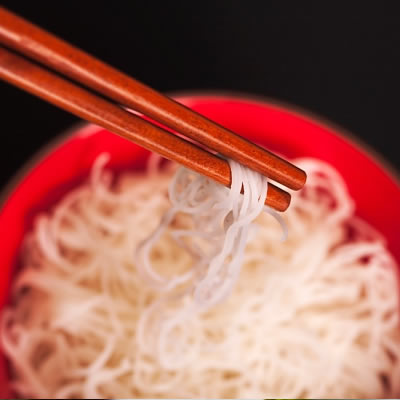
A staple food in East and Southeast Asia, noodles are generally made from wheat flour, rice flour, or mung bean starch. The oldest noodles discovered were made from millet, an ingredient which is no longer commonly used.
Rice noodles are made from rice flour and water without salt, although sometimes tapioca or cornstarch is added for extra gelatinous and chewy texture. These noodles cook faster than its Western counterpart, reaching al dente in 5 minutes or less. They may be cooked in moist or dry forms, boiled or deep-fried. Rice noodles come in various forms, the more popular versions are: Kway teow, flat noodles; Ho fun, wide flat noodles; Lai fun, thick round noodle; Vermicelli, thin rice noodles.
RENDANG
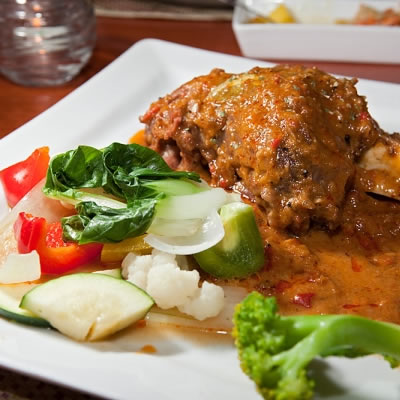
This is a dish that originates from the Minangkabau ethnic group of Indonesia, and has now become popular not only across the entire country of Indonesia, but also in neighbouring Malaysia and Singapore.
There is a widespread misconception that rendang is a type of curry. Even in the countries where it is commonly enjoyed, certain curried meat dishes are mistakenly referred to as ‘rendang curry’. In actual fact, authentic rendang bears little to no resemblance to curry.
Traditional rendang is typically made from beef, although chicken, mutton, water buffalo and duck can also be used as the main protein. In certain versions, jackfruit and cassava can be used in place of meat. The meat is cooked slowly in spices (which may include ginger, galangal, turmeric leaf, lemongrass and chilli) and coconut milk for several hours until the liquid is almost completely reduced. This slow cooking process allows the meat to completely absorb the flavour of the spices and become very tender.
Because it requires time-consuming preparation, rendang was traditionally only prepared for ceremonial occasions and honoured guests. These days, however, rendang that’s sold commercially is becoming more common, allowing people to enjoy this delicious treat daily. Although it has to be said, homemade rendang is always best.
There are two types of rendang: wet and dry. Dry rendang can keep for 3 to 4 months without refrigeration. Wet rendang has more gravy, but must be consumed within a month if not refrigerated.
RED TORTOISE CAKE
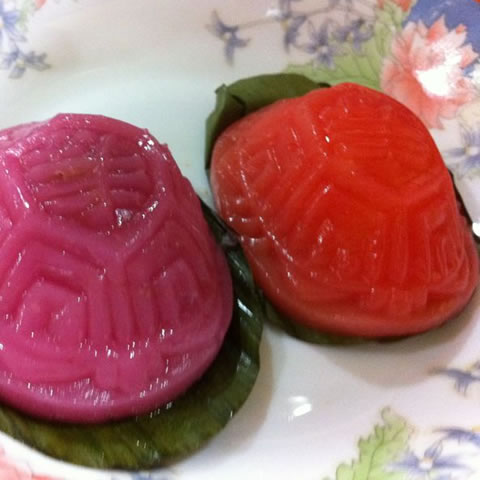
Red tortoise cake, also known as Ang ku kuih to the Hokkiens, is a small round or oval shaped pastry with soft sticky glutinous rice flour skin wrapped around a sweet filling in the centre. It is moulded to resemble a tortoise shell on a square piece of banana leaf.
Traditionally red in color, Red tortoise cake has a sticky chewy texture when eaten. Red tortoise cakes are shaped like tortoise shells because the Chinese traditionally believed that eating tortoises would bring longevity to those who are eating it and bring about good fortune and prosperity. Considered to be auspicious items, these sweet pastries are especially prepared during important festivals such as Chinese New Year as offerings to the Chinese deities. Also prepared during special ocassions, which are culturally important to the Chinese such as a newborn baby’s first month or birthdays of the elderly. Eating red tortoise cakes during these times are meant to represent blessings for the child and longevity for the elderly.
In modern times, red tortoise cakes is considered as a culturally important food during Chinese festivals in many countries such as Singapore, Malaysia, China and Taiwan. However, eating red tortoise cakes in these countries is no longer restricted to special occasions for red tortoise cakes are also commercially available in many pastry shops, bakeries and morning markets. As such, the color may also vary, from green to yellow to pink.
The skin is usually made from glutinous rice flour and sweet potato whereas the fillings are made from precooked ingredients such as mung bean or grounded peanuts and sugar. After kneading and molding the ingredients together, the red tortoise cakes are steamed on a piece of banana leaf.
RED CURRY

Red curry, also known as kaeng phet, is one of the more popular Thai curries. Its name derives literally from the colour of the dish, such as the equally well-known green curry. Unlike green curry, which is made from fresh green chilies, red curry paste is formed by pounding dried red chilies together with garlic, shallots, galangal (blue ginger), shrimp paste, kaffir lime and a host of other fragrant local ingredients.
Thai Red Curry is known for burning intensely yet briefly, a trait we have the Portuguese missionaries to thank for as they introduced spicy chilies to Thai cooking during the late 17th century. Masters of improvisation, the Thais borrowed dishes from neighbouring countries while substituting ingredients – spices were replaced with fresh herbs, dairy products with coconut milk – to create a unique local flavour.
RAMBUTAN
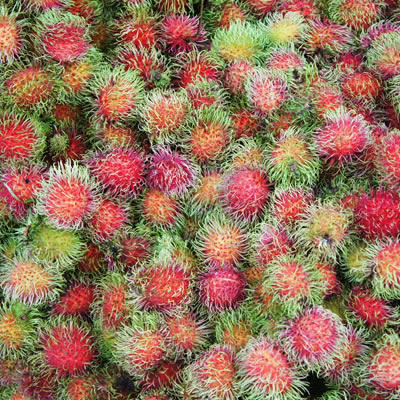
Rambutan is a medium-sized tropical tree in the family Sapindaceae. It is native to Indonesia, Philippines, Sri Lanka, Malaysia, and elsewhere in Southeast Asia. It is closely related to several other edible tropical fruits including the Lychee and Longan. The name rambutan is from the Indonesian word rambutan, which literally meanshairy referring to the spiky rind on the fruit, and is in general use in the Indonesian, Filipino, and Malay language.
Without the soft spines on the rind, the rambutan would resemble the lychee, which is in the same botanical family. The structure internally is quite similar, with a single central inedible seed and edible white flesh wrapped around it but the skin is the part that makes the rambutan so distinctive in appearance.
Rambutan is adapted to warm tropical climates, around 22-30ºC, and is sensitive to temperatures below 10ºC.
Rambutans are most commonly eaten out-of-hand after merely tearing the rind open, or cutting it around the middle and pulling it off. It does not cling to the flesh. The peeled fruits are occasionally stewed as dessert. They are canned in syrup on a limited scale.
PORTUGUESE EGG TART
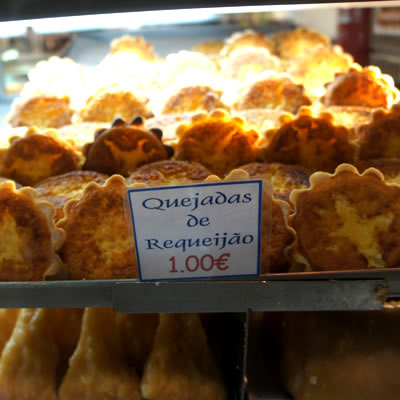
Portuguese egg tart was evolved from “pastel de nata”, a traditional Portuguese custard pastry that consists of custard in a creme brulee-like in a puff pastry case.
It is believed that this tart was created before the 18th century by Catholic nuns at the Jeronimos Monastery of Belem, in Lisbon. Macau being a former colonised country of Portugal, naturally adapted this cuisine too. It has since become available at numerous bakeries and Macau-style restaurants as well as Hong Kong and Mainland China branches of the KFC restaurant chain. Portuguese-style egg tarts became popular in Singapore, Malaysia, Hong Kong, Taiwan and Thailand in the late 1990s, popularized by franchises such as Lord Stow’s bakery.
They differ from the egg tarts found in Chinese dim sum shops as they are less regularly shaped, with a burned and wrinkled top. And, instead of the deep aroma of egg yolk and milk you would expect from typical egg tarts, for good Portuguese egg tarts, you would be able to taste the slightly burnt sweet taste of caramel and custard.
PETAI
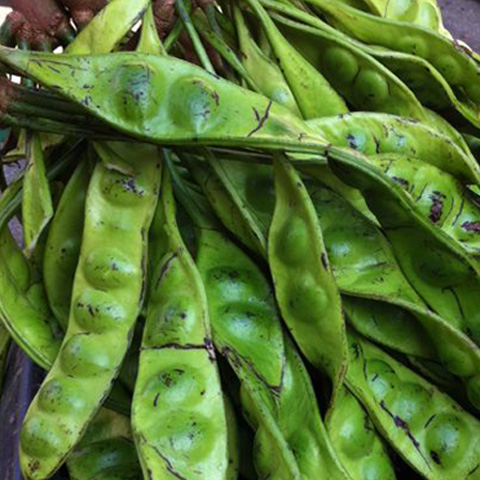
Petai originates from the Parkia speciosa species. This twisted cluster bean, is also known as petai, pete or peteh. It is a popular culinary ingredient in Indonesia, Malaysia, Singapore, Laos, southern Thailand, Burma, and northeastern India.
In Indonesia, petai is very popular in the highlands of Java and Sumatra, especially among Sundanese, Minangkabau.
In Malaysia, petai is commonly served with sambal (chilli-based sauce used as condiment), or mixed with dried shrimp, chili peppers, red onions, belacan (shrimp paste), soy sauce and minced meat. In Thailand it is called sato), usually added to a Thai curry such as Thai Duck Green Curry, or as mu phat sato, stink bean with stir fried pork.
Petai beans or seeds look like broad beans. Like mature broad beans, they will be peeled before cooking. Petai has earned its nickname ‘stink bean’ because of its strong smell. It lingers in the mouth and body. Like asparagus, it contains certain amino acids that give a strong smell to one’s urine, an effect that can be noticed up to two days after consumption. Like other beans, petai can also cause strong-smelling flatulence.
PESTLE AND MORTAR
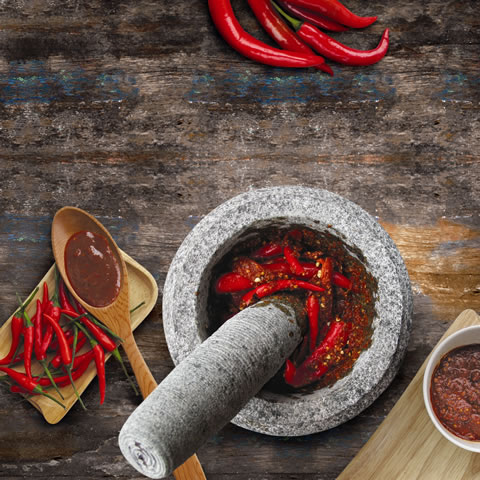
Pestle and mortar is a tool used to crush, grind, and mix solid substances. The pestle is a heavy club-shaped object, the end of which is used for crushing and grinding. The mortar is a bowl, typically made of hard wood, ceramic or stone. The substance to be grounded is placed in the mortar and ground, crushed or mixed with the pestle.
It is typically used for grinding dried spices like whole coriander seed or other seeds. It can also be used to mash things into a paste like garlic with fresh spice leaves such as basil or mint. Used as a very handy cooking utensil, the pestle and mortar is commonly used in Thai cooking, such as making curry paste. With the use of a pestle and mortar, the crushing the fibers of herbs releases the full range of oils or moisture they contain, and gives chilli sauces and curry paste a greater depth of flavor, compared to chopping them, which causes them to appear dry. This is especially when dealing with aromatic roots, such as lemon grass, galangal, kaffir lime, basil, chives, dill, fennel, and lavender, to name a few.
PENANG PRAWN NOODLE
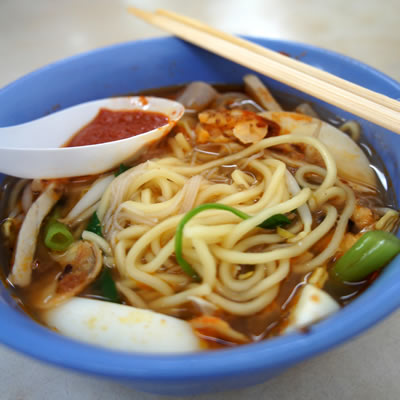
Penang Prawn Noodle is the cuisine of the multicultural society of Penang, Malaysia. Mostly sold at road-side stalls, it is best known as a “hawker food”. It is also known as Hokkien Hae Mee. It is a dish of egg noodles and rice noodles in a fragrant stock, which is made from fresh shrimp and dried prawns, as well as pork or chicken. Traditionally, small cubes of fried pork fat are added to the soup, but this is now less common due to health concerns. It is garnished with prawns, fish cake, leafy greens (usually water spinach or better known as kangkung to the locals), pork ribs, squid, crisp deep-fried shallots, spring onions and fresh lime. The dish is served with sliced red chili, and sambal. Sometimes depending on location if the stall sells Loh Mee or Hokkien Mee you can request for them to mix half Loh Mee sauce with the Hokkien Mee soup.
In Singapore, Hokkien mee refers to a variant of the Penang version of Hokkien hae mee. The dish uses the same egg and rice noodles used in Hokkien hae mee, but is stir-fried in lard and served dry. The main ingredients are shrimps and small pieces of sliced pork. It is usually served with lime and sambal chilli.
* Loh Mee is rice and egg noodles in broth thickened with corn starch and beaten eggs, served with eggs (some feature duck eggs), meat slices and bean sprouts.
PENANG ASAM LAKSA
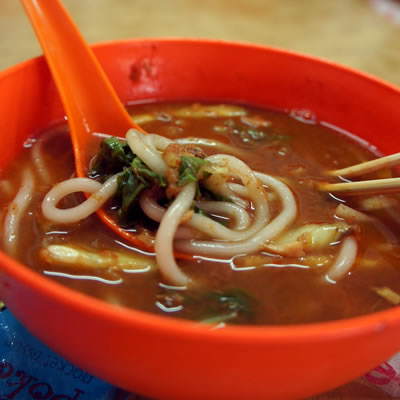
One dish that every tourist must try out when visiting Penang, Malaysia is the Asam Laksa. It is available at many hawker stalls and eateries throughout the island, although the most famous asam laksa stall in Penang is the one at Air Itam market.
The ingredients used in creating this tantalizing dish are simple and can be found almost anywhere. Garlic, lemongrass, fresh turmeric, shallots, chilli paste and belacan are all grounded into a paste before starting on the broth. Tamarind paste is then mixed with warm water, squeezed and sieved into a stock pot and brought to boil. Vietnamese mint leaves, sugar, dried tamarind slices or locally known as asam keping, slices of torch ginger bud or ‘locally known as bunga kantan’ and the ground paste of spices are added into the boiling broth. Cleaned whole mackerel fish is then added into the stock and boiled until cooked. The fish is then removed, set to cool before cleaning off the bones and flaking its meat. The broth is simmered to reduce and intensify the flavours. The mint leaves and dried tamarind slices are removed before putting in the flaked fish meat. It is usually served with thick rice noodles garnished with sliced cucumber, pineapples, onions, mint leaves and a spoonful of thick prawn paste.
PANDAN
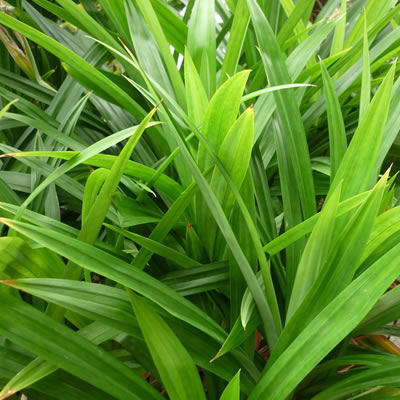
Pandan is a tropical plant and is used widely in Southeast Asian cooking as a flavoring. It is an upright green plant with fan-shaped sprays of long, narrow, bladelike leaves and woody aerial roots. In Bangladesh it is called Ketaki and used to enhance the flavor of biryani and sweet coconut rice pudding, payesh. It is called pandan wangi in Indonesian, soon-mhway in Burmese, bai tooey in Thai, and lá dứa in Vietnamese.
The leaves are used either fresh or wilted, and are commercially available in frozen form in Asian grocery stores in nations where the plant does not grow. They have a nutty, botanical fragrance which enhances the flavor of Indonesian, Singaporean, Filipino, Malaysian, Thai, Bangladeshi, Vietnamese, Chinese and Burmese foods, especially rice dishes, cakes and desserts.
Pandan chicken, is a Thai dish with chicken wrapped in pandan leaves and fried.
The leaves are also used as a flavoring for desserts such as pandan cake, sweet beverages such as bobo chaha, and the malay delicacy called Onde-Onde.
PAD THAI

Pad Thai, which literally means “Thai-style frying”, is one of Thailand’s national dishes and well-loved outside of Thailand. And no surprise, as it presents a tasty symphony of flavours and textures in a simple plate of stir-fried rice noodles
This dish is believed to have been brought to the ancient Thai capital of Ayutthaya by Vietnamese traders. Ayutthaya or Siam, which existed from 1351 – 1767, was one of the biggest and wealthiest cities in the East – a land of lush surroundings, intricate temples, gilded palaces and exotic culture.
Pad Thai became popular as a national dish in the 1930s and 1940s, when the Thai government encouraged the production and consumption of rice noodles in an effort to export more rice to other countries. Since then, two different styles of Pad Thai have evolved – the dry, light version found in the streets of Thailand, and the heavier, oilier version that dominates restaurants in the West.
PAD KI MAO
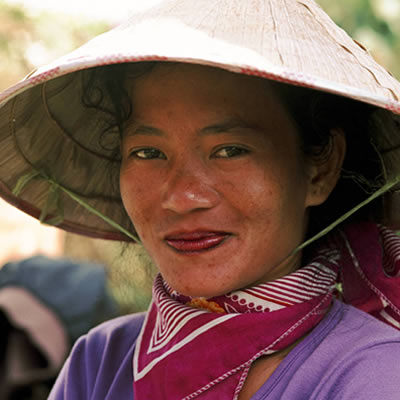
Pad Ki Mao or Pad Kee Mao is a popular spicy stir-fried street dish which is found in Laos and Thailand. Made popular by the Chinese ethnic community, it shares a similar appearance with the Malaysian noodle dish Char Kway Teow but is much more spicy in flavour.
Taking the words “Pad” (meaning stir-fry) and “ki mao” (drunk) literally translates to Drunken Noodles as it is a popular street food to have with beer. Ki Mao – when associated with a dish – refers to a mix of fresh chilies, peppercorns and holy basil, which is what gives Pad Ki Mao that extra kick over the national dish, Pad Thai.
This dish is commonly cooked with flat, wide rice noodles and a mix of soy sauce, fish sauce, garlic and bean sprouts, but its versatility allows it to be made with other noodles, spaghetti, and rice.
NYONYA CUISINE

In the 15th century, Chinese immigrants who settled in South East Asia inadvertently impacted the region with changes that were more than simply cultural. Assimilation by the local Malays resulted in the birth of Nyonya cuisine.
Fusing Chinese ingredients and cooking techniques with Malay spices, Nyonya cooking is aromatic, flavourful, spicy and herbal. While Nyonya dishes originating from the North and South are different due to influences from respective neighbouring countries, both rely heavily on local ingredients such as chilies, Belacan (Malaysian shrimp paste) lemongrass, galangal (Blue Ginger) and turmeric. The flavour and authenticity of a dish is determined by how well the spices are prepared with a pestle and mortar.
NINTH DAY OF CHINESE NEW YEAR
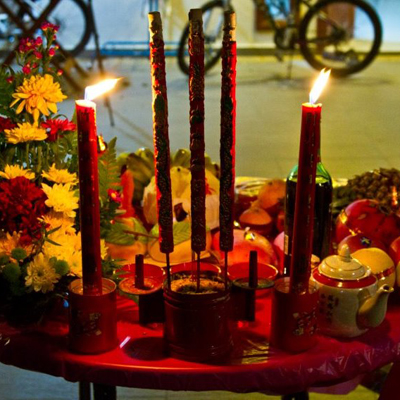
The ninth day of the New Year is a day for Chinese to offer prayers to the Jade Emperor of Heaven (天公, Tiāngōng). The ninth day is traditionally the birthday of the Jade Emperor. This day is especially important to Hokkiens. Come midnight of the eighth day of the new year, Hokkiens will offer thanks giving prayers to the Emperor of Heaven. Offerings will include sugarcane, incense, tea, fruit, vegetarian food or roast pig, and gold paper is served as a customary protocol for paying respect to an honored person.
A specially alter is set up outside one’s home with a wide spread of food offerings, including piglet, Angkoo Kuih, which comes in multiple colours, many shapes and varieties of filling ranging from peanut, mung bean and red bean filling, glutinous rice dumplings, red hard boiled eggs, chinese steamed cakes, mandarin oranges, yellow noodles, and chinese tea among others. These offerings are then arranged in a certain order on red tables facing the main gate and the main gate will usually be wide open.
Bright sparks and loud booms filled up the dark night and it continuously goes on all night long till approximately 4am.
NASI LEMAK
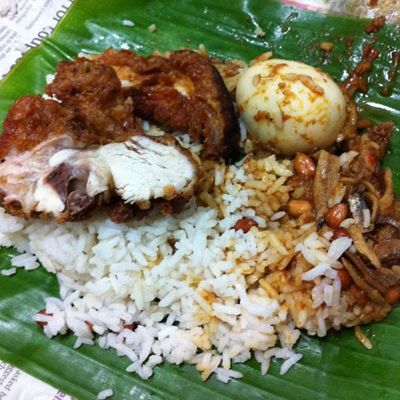
Nasi lemak is widely eaten in Malaysia and Singapore. Commonly eaten as a breakfast or supper dish in both countries, it is normally sold at hawker food centres or roadside stalls. It often comes wrapped in banana leaves, newspaper or brown paper,and it could be served on a plate. Some restaurants even serve it as a noon or evening meal, making it available for the dish to be eaten all day.
With roots in Malay culture, its name in Malay literally means “fatty rice”, but is taken in this context to mean “rich” or “creamy”. The name is derived from the cooking process whereby rice is soaked in coconut cream and then the mixture steamed. Sometimes knotted pandan leaves are thrown into the rice while steaming to give it more fragrance.
A platter of nasi lemak is usually wrapped in banana leaves, with cucumber slices, small fried anchovies, fried or roasted peanuts, hard boiled egg, and hot spicy sauce , also known as sambal to the locals. Nasi lemak can also come with a variety of other accompaniments such as chicken, cuttlefish, cockles, stir fried water convolvulus (kangkung), beef rendang (beef stewed in coconut milk and spices) or paru (beef lungs). Traditionally most of these accompaniments are spicy in nature.
MURUKKU
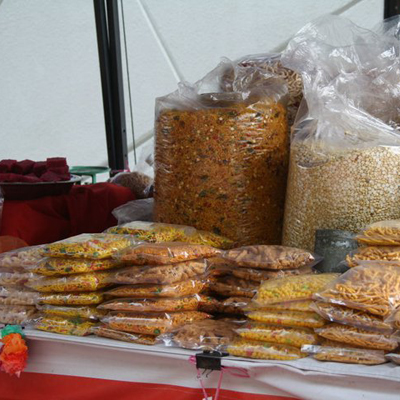
Murukku is a savoury snack popular in India and Sri Lanka, originating in the cuisine of the South and West India.
Murukku is typically made from a mixture of urad and rice flour, salt, and flavourings such as chili, asafoetida, ajawain, cumin and other spices.
The mixture is made into a batter, mechanically extruded, formed into a spiral or coil, and fried to a crisp. Murukku can also be rolled into a flat ribbon (ribbon murukku) or shaped by hand (kai murukku). Kai suthu murukku (Hand spun) is prepared by getting a string of dough and twisting it while winding it into a ring. This process is very hard, requires patience and is highly technical work.
It is popular among the Indian residents of Fiji, and among Indian Fijians in North America. Murukku is traditionally enjoyed as a treat on Diwali.
More recently, murukku has become available in North America, and is made by several manufacturers in the United States. Murukku has also found its way into the UK market.
MOONCAKE
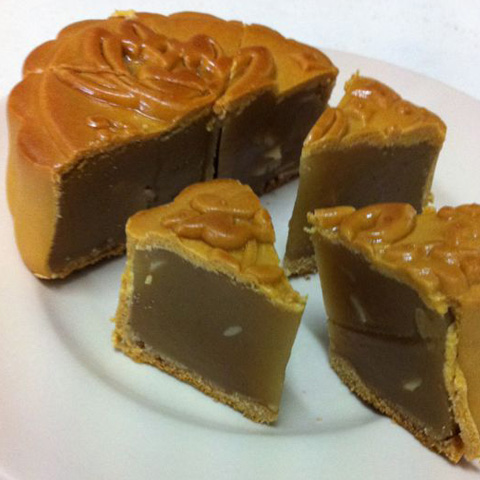
Mooncake is a Chinese delicacy traditionally eaten during the Mid-Autumn Festival which usually falls around September. The festival is for lunar worship and moon gazing, when mooncakes are regarded as an important delicacy. Mooncakes are offered between friends or on family gatherings while celebrating the festival. It is most commonly presented as a gift item. The Mid-Autumn Festival is one of the very important Chinese festivals, on top of Chinese New Year and Dragon Boat festival.
Typical mooncakes are round or rectangular pastries, measuring about 10 cm in diameter and 4–5 cm thick. Its filling is made from lotus seed paste or red bean paste is surrounded by a 2–3 mm crust and may contain yolks from salted duck eggs.
Mooncakes are usually eaten in small wedges accompanied by Chinese tea. Today, it is customary for businessmen and families to present them to their clients or relatives as gifts.
These days, mooncakes come in various flavors such as cream cheese, chicken floss, tiramisu, green tea, durian, chocolate, mango, etc.
MASSAMAN CURRY
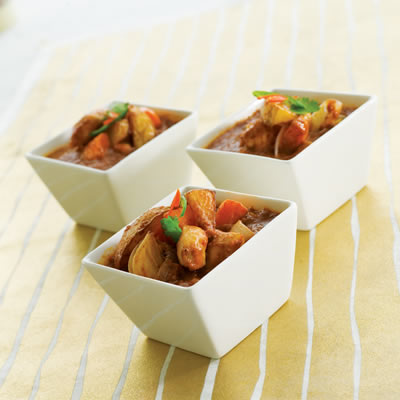
Curry can be defined as a savoury, stew-like dish native to India, Pakistan, Sri Lanka and South East Asia. Massaman curry is a southern Thai dish which is believed to be Muslim in origin as many of the dry spices were brought to Thailand by early Muslim traders. The name Massaman may be derived from the Arabic word Musulman, which is a synonym for Muslim.
Thai curries are usually soupy, made from delicious pastes, coconut milk or water, meat, vegetables or fruit, and herbs and spices. The varying combinations make it such a delectable dish enjoyed all over the world.
In Thailand, curries are usually eaten spooned over plain steamed jasmine rice or khanom jeen (round rice noodles), to balance the heat and intensity of the flavours. The locals pair curries with bland soups, slightly bitter vegetables and salty dishes like fried fish to achieve a harmony of flavours.
MAMAK STALL
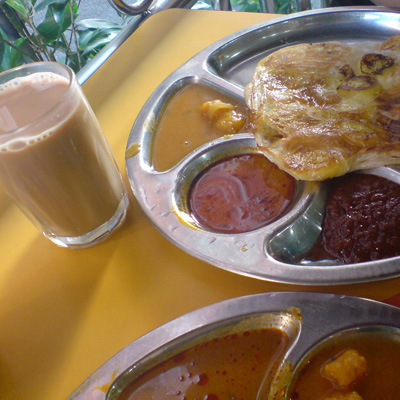
A mamak stall, is a food establishment which serves mamak food. In Malaysia, the term mamak refers to Tamil Muslims, who generally own and operate them. Although traditionally operated from roadside stalls, some modern mamak stall operators have expanded their businesses into restaurant or cafe-type establishments with air-conditioning units. Mamak stalls tend to be popular among Malaysian youths as hang out spots, due to cheap food and beverages, being served 24 hours a day, 365 days a year.
People of all races, religions and ages frequent mamak stalls to gossip or catch a late-night football game while enjoying a cup of hot teh tarik. No other eatery has quite as much cultural significance in Malaysia.
Mamak stall usually offers different varieties of roti canai to eat and teh tarik or Milo to drink. Most mamak stalls also serve several varieties of rice, such as nasi lemak and nasi goreng (fried rice), as well as noodle dishes such as mee goreng (fried noodles).
A typical Mamak stall will offer the following dishes, though this differs from stall to stall:
• Roti Canai
• Roti Telur
• Teh Tarik (literally ‘Pulled Tea’)
• Half-Boiled Eggs
• Goat Milk
• Murtabak
• Thosai
• Chapati
• Nasi Lemak
• Nasi Goreng
• Maggi Goreng
• Mee Goreng
• Rojak
• Roti Tissue
• Roti Bom
• Roti Naan & Tandoori Chicken
MALAYSIA HOKKIEN NOODLES
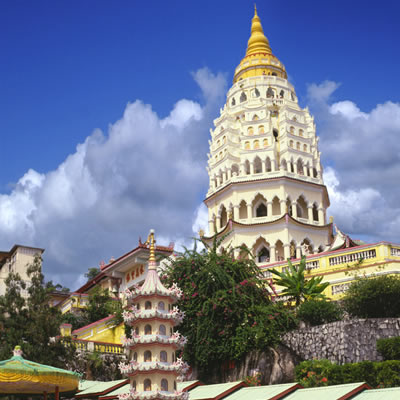
Malaysian Hokkien noodles (Hokkien mee) is a popular fried noodle dish prepared in the Chinese Fujian cooking style. There is a slight ambiguity in regards to the dish as it differs according to locale: in the Klang Valley, it is a stir-fried yellow noodle in dark sauce, whereas in the Northern state of Penang, Hokkien Mee refers to the soup-based prawn noodle.
The Penang version relies very much on its fragrant stock, created from fresh and dried shrimp as well as chicken and pork. The better-known dry variant calls for a liberal use of pork fat (which in many cases can make or break a good Hokkien Noodle). The noodles are braised in a simple yet aromatic concoction of oyster, dark and light soy sauce, and stock. Due to a local preference for all things spicy, Hokkien Noodles are served with a side of Sambal Belacan comprising chilies, shrimp paste, lime and salt.
MALAYSIA CHAR KOAY TEOW
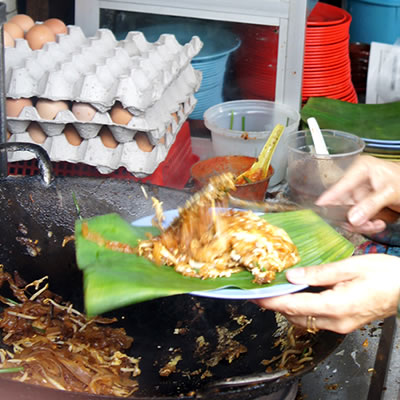
Eating street food is a favourite form of dining in Malaysia, and one of the most famous Malaysian street food dishes is char koay teow, which was believed to have been created by South-East Asian Chinese. It is essentially a stir-fried dish and its main ingredient – koay teow – is a flat rice noodle that one could describe as resembling a lighter version of tagliatelle. Translated from Hokkien, the dish’s name simply means ‘fried koay teow’.
However, there’s more to this dish than just rice noodles. A typical plate of fried koay teow also has cockles, Chinese chives, Chinese sausages, chilli, fish cakes, bean sprouts, prawns, eggs, dark soy sauce, light soy sauce and sinful, flavour-packed crisp croutons of pork lard. It is sometimes served on top of a banana leaf for additional fragrance.
There are many variations of this dish that can be found throughout Malaysia and South-East Asia, some adapted to use locally-available ingredients and perhaps some adjusted to suit local taste preferences. But the gold standard for char koay teow – recognised by connoisseurs as being the best in the world – originates from the island of Penang in Malaysia. The next time you travel to this part of the world, don’t forget to give it a try!
LONGAN
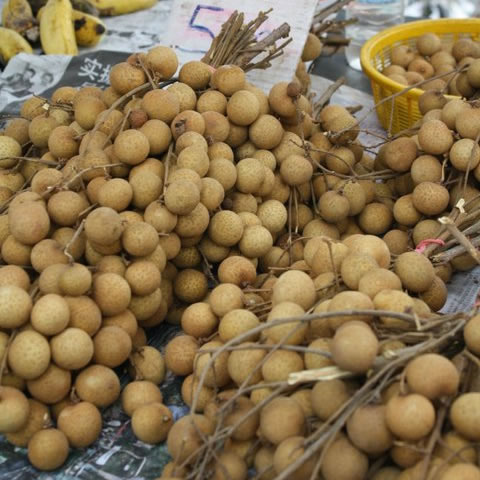
Longan, translated literally as “dragon eye” because it resembles an eyeball when its fruit is shelled (the black seed shows through the translucent flesh like a pupil/iris). The seed is small, round and hard, and of an enamel-like, lacquered black. The fully ripened, freshly harvested shell is bark-like, thin, and firm, making the fruit easy to shell by squeezing the fruit out as if one is “cracking” a sunflower seed. When the shell has more moisture content and is more tender, the fruit becomes less convenient to shell.
The edible longan fruit is juicy, succulent and very sweet, and can be eaten fresh or use it fresh or in its dried forms in soups, desserts and snacks.
Typically served as a chilling dessert to quench thirst, longan is served at any time of the day as a relaxing drink or after meals as dessert. While there are different methods of cooking longan, dates, gingko nuts and snow fungus are commonly featured in the recipes. The “longan tong sui”, which means “sugar water,” is a popular dessert which can be easilly prepared at home.
LEMONGRASS
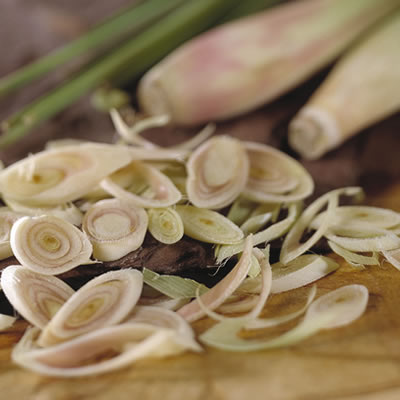
Lemongrass refers to about 55 species of grasses that are native to India. It has a citrusy flavour and is widely used as an herb in Asian cuisine – either in fresh, dried or powdered form.
Lemongrass is suitable to be used together with poultry, fish and seafood. It can be brewed as a tea, not only in Asia but in Africa and Latin America as well. It is also used in curries and soups – perhaps the most famous of which is Thailand’s fiery tom yam soup. When used in such a manner, the lemongrass is usually not eaten but pounded to better release its aroma being dropped whole into the soup and then used as a garnish or discarded after cooking.
The plant is key to the production of citronella oil, used in aromatherapy oils and soaps – which brings the distinctive aroma of lemongrass to the famous spas on the island of Bintan, Indonesia.
KHAO SOI
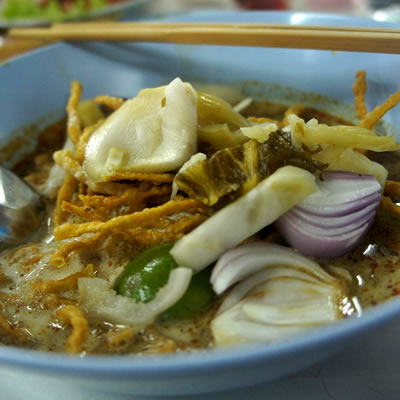
Khao Soi or Khao Soy is a Burmese-influenced dish served widely in northern Laos and northern Thailand. The name means “cut rice”. As the name suggest, the rice noodle dough is laid on a cloth stretched over boiling water. After steaming, the large sheet of noodle dough is then rolled and cut with scissors.
There are two common versions of Khao Soi. Laotian Khao Soi is a soup made with wide rice noodles, coarsely chopped pork, tomatoes, fermented soy beans, chillies, shallots, and garlic, then topped with pork rind, bean sprouts, chopped scallions, and chopped cilantro.
In northern Thailand, there is a similar dish known as Thai khao soi, which is a soup-like dish made with deep-fried crispy egg noodles, pickled cabbage, shallots, lime, nam phrik phao (chilli based condiment), and meat in a curry-like sauce containing coconut milk. The curry is similar to yellow Massaman curry, but thinner. Though northern Laotians have a special way of preparing this dish, different versions can be found at Laotian restaurants. Popular as a street dish, it is eaten by Thai people, though not frequently served in Western Thai restaurants.
There is some reason to believe that the Thai version of Khao Soi was influenced by Chinese- Muslim cuisine and is therefore served with chicken or beef.
KAFFIR LIME
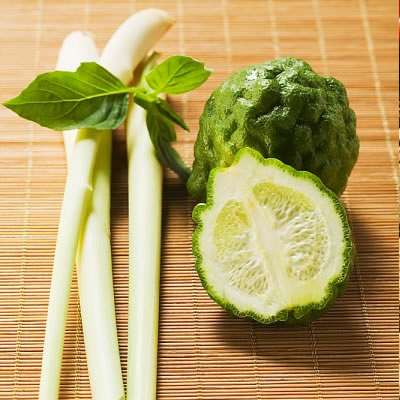
Kaffir lime is an unlovely fruit with a bumpy exterior and unique hourglass-shaped leaves. It plays an essential role in Thai, Indonesian, Vietnamese and Malaysian cooking. Interestingly enough, unlike other citrus fruits, its leaves and rind, rather than its zest and juice, are used for cooking.
Its unique citrus fragrance is instantly recognisable to those who favour South East Asian cuisine, so much so that aficionados insist that its flavour cannot be replaced by other similar ingredients. In soup dishes, the leaf is added whole into the dish while for salads it is sliced into thin strips for garnishing. In Thailand, kaffir lime is so beloved that many homes have at least one tree growing in their gardens.
JACKFRUIT
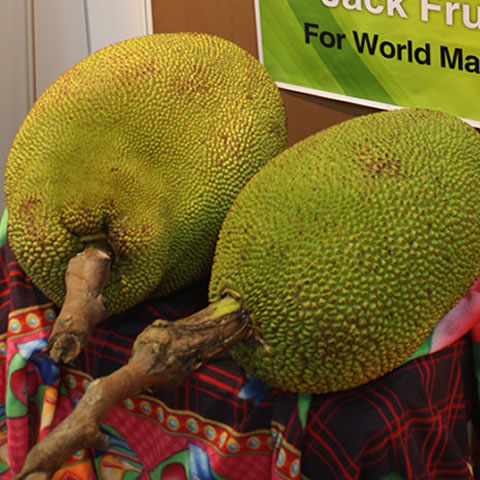
Jackfruit is the largest tree-borne fruit in the world. It can reach up to 80 pounds in weight and 36 inches long and 20 inches in diameter. The inside of the fruit is made up of large edible bulbs of yellow, banana-flavored flesh that encloses a smooth, oval, light-brown seed. The seed The jackfruit trees are native to India, Bangladesh, Nepal, Phillipines and Sri Lanka but but also commonly grown in Malaysia
Enormous and prickly on the outside, jackfruit looks abit like durian although it is usually larger. Once a jackfruit is cracked open, what you will find inside are “bulbs”. Often referred to as the seeds, these bulbs are actually a kind of fleshy covering for the true seeds or pits, which are round and dark like chesnuts. The fleshy part (the “bulb”) can be eaten as is, or cut up and cooked. Even the seed can be eaten after they are steamed.
When cutting up fresh jackfruit, it’s a good idea to oil your knife and hands first before cutting, as the fruit is very sticky.
INDONESIAN NASI GORENG
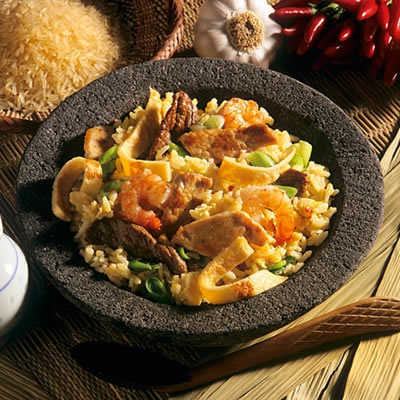
There are many varieties of stir-fried rice dishes throughout Asia. This is likely due to the fact that most Asian communities consume rice as a staple, and there is a constant need to turn leftover rice into a hot, fresh, delicious meal.
So what makes Indonesian nasi goreng different? It may be the fact that Indonesians typically like to fit all sorts of flavours and textures into one bite of food. So Indonesian nasi goreng features a large variety of ingredients: shrimp paste, chilli, garlic, shallots, lettuce, cucumber slices, tomato slices, fried shallots, prawn crackers, shredded chicken and eggs. All these create a kaleidoscope of flavours and textures with every mouthful.
In restaurants, this dish is often served as a main meal, and accompanied by side dishes such as fried chicken, satay and vegetables. There is also a more luxurious version typically served in high-end establishments that is accompanied by more expensive ingredients such as prawns.
Indonesian nasi goreng is an extremely versatile dish to which you can add just about any ingredient – from fried chicken to grilled beef to seafood. The next time you get a chance to try this dish, don’t forget to experiment… mix and match and see which combination you like best!
INDIA ROJAK
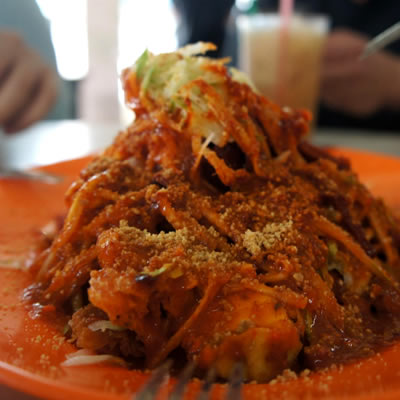
Indian Rojak is a traditional fruit and vegetable salad dish commonly found in Malaysia and Singapore. The term “Rojak” is Malay for mixture. In Malaysia, mamak / Indian rojak (or Pasembor) contains fried dough fritters, bean curds, boiled potatoes, prawn fritters fried in batter, hard boiled eggs, bean sprouts, cuttlefish and cucumber mixed and served with a sweet and spicy chili sauce and lazed with peanut or sesame bits. Traditionally, Tamil Muslim (Mamak) rojak vendors used modified sidecar motorcycles as preparation counters and to peddle their rojak. These mobile vendors now use modified mini trucks. The peddler’s only tools would be his cutting board, a knife and the large mixing bowl. The rojak would be cut and mixed on the spot. Toothpicks or Satay sticks pierced through the first few vegetables are served as forks.
In Penang, Malaysia where it is very famous, it is always called Pasembor, but in Kuala Lumpur and Singapore it is called rojak. Today, a variation of the Rojak has multiplied as new ingredients are creatively added to the spicy, sweet and sour black sauce. More often than not, the dish is found in hawker centres, food courts and even night markets.
INDIA BANANA LEAF RICE
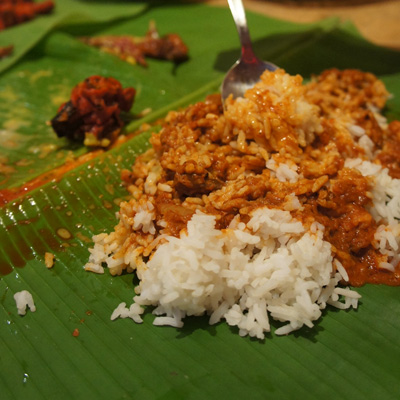
Banana leaf rice is a typical dish in South Indian cuisine. White rice (or parboiled rice in authentic South Indian restaurants) is served on a banana leaf with an assortment of vegetables, curried chicken, mutton meat or fish, pickles, and/or papadum. Most of the time, however, only the gravy of the curry will be served and no meat is served as it is meant to be a traditional Indian vegetarian dish. It is traditionally eaten with the hand.
The banana leaf is used as it is believed that the hot rice will release the coating on the banana leaf, which aids in digestion.
Depending on restaurants, tomato rice is also available. Diners can have the option to choose from a variety of vegetable dishes, curried meat / fish dishes, fried chicken or even crispy fried squid. Indian banana leaf rice shops will usually have a delicious, mouth-watering dish which is made from raw cucumber, onions and pineapple mixed as a salad with a little vinegar and sugar. Papadums (thin cracker made with black gram, jackfruit and tapioca) are then served as an accompaniment to a meal, together with a selection of curries for you to douse over the rice.
In Malaysia, to show your appreciation after a satisfying meal, fold the banana leaf towards you (i.e. inwards) to signify that the meal was good. Folding the opposite direction (i.e. away from you) signifies that the meal was not satisfying.
GREEN CURRY
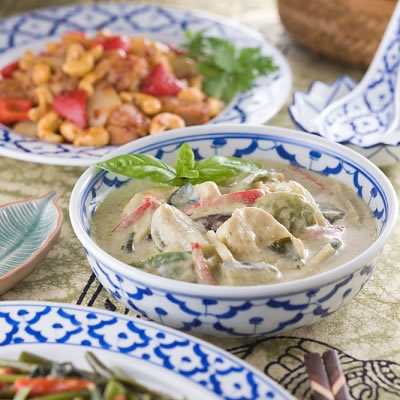
Green curry originated in Asia and spread to the rest of the world during the Ayutthaya period when Siam open its doors to trade. Its name is derived literally from the colour of the dish, like other variants such as yellow and red Thai curries.
Green curry can be very spicy as well but its distinguishing taste lies in its extra sweetness not usually associated with other curries. Green curry paste is made by pounding green chilies, shallots, garlic, galangal (blue ginger), fresh turmeric, shrimp past and salt. This paste is mixed with liberal amounts of coconut milk and other aromatic ingredients like fish sauce, kaffir lime leaves and Thai basil leaves to create fragrant Thai Green Curry.
All kinds of meats can be incorporated into green curry – beef, pork, chicken and fish ball are the more popular variants. Green curry is usually eaten with a side of rice or rice noodles known as khanom jeen.
GARLIC
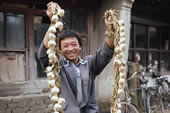
Garlic is ubiquitous in the art of cooking in the Middle East, northern Africa, southern Europe, and regions across South and Central America, but especially in Asian culture. It is a well-known fact that the heavily pungent herb is featured extensively in stir-fried dishes as well as in bases for soups and curries, but few realise the impact it had on Chinese literature as well. The Shi-ching – a compilation of classic Chinese poetry – mentions garlic and its importance to the country’s development.
In food preparation, garlic is used as an aromatic bed for shallow-poached items, or in sauce reduction. Roasting garlic brings out a rich, sweet and smoky taste and is a less commonly used technique in Asian dishes than it is for western fare.
GADO-GADO
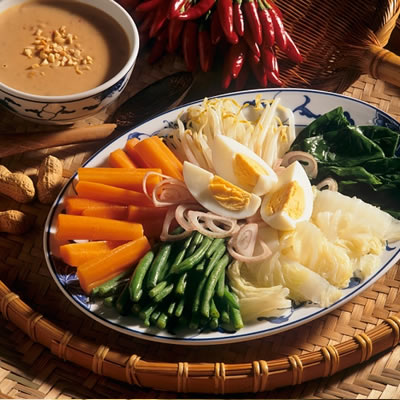
Gado-gado is a popular traditional Indonesian salad of mixed vegetables dressed with a delicious peanut sauce. The sauce is a vital part of the dish, often made in individual batches in front of customers to retain its authenticity. Gado-gado is served from hawkers’ carts, street-side stalls and restaurants in Indonesia as well as other countries.
Gado-gado is the traditional food of the Betawi, descendants of people living around Batavia (the colonial name for Jakarta) from around the 17th century. The Betawi people are descended from various Southeast Asian ethnic groups, Portuguese and Dutch plus Arab, amongst others. They are known for their music, traditions and food as well as their directness and openness to others.
Due to its popularity, the term gado-gado is even used to informally describe things which are mixed with one another or things which are not well-categorized.
FINE DINING IN KUALA LUMPUR
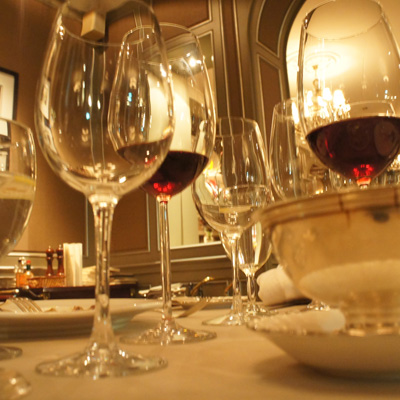
The term Fine Dining brings to mind all kinds of images, from crisp white table cloths to waiters in tuxedos. Fine dining, just as the name suggests, offers patrons the finest in food, service and atmosphere.
Kuala Lumpur, Malaysia is a food haven – with a large population brimming with different races and cultures, it doesn’t take very much to find a place to eat with a variety of traditional food for you to savour. Chinese, Malay, Indian, Nyonya and European cuisines are easily available here. It offers its patrons a wide variety of food to choose from, from street food, budget eateries, such as mamak stalls to scrumptious dining experience at high-end quality food, served quipped with perfect ambience and great hospitality. On top of that, Kuala Lumpur’s cosmopolitan lifestyle means that there are plenty of international eateries and fine food for those who want a touch of home away from home.
There are many fine dining restaurants in KL, many located in the various Hotels around town while some are independent restaurants providing intimate dining experience to celebrate special occasions, whilst enjoying exquisite meals prepared by some renowned and experienced chefs.
The list of fine dining restaurantsi in KL are available at:
http://www.kuala-lumpur.ws/food-dining/finedining.htm
ENOKI MUSHROOMS
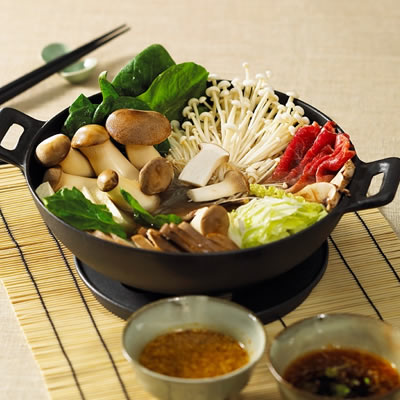
Enoki is the Japanese name for the long, thin white mushrooms that are so commonly used in Japanese, Chinese and Korean and other Asian cuisines. Looking at it, it’s easy to see why the Chinese call it ‘golden needle mushrooms’.
It is interesting to note that the enoki sold in supermarkets are always cultivated in narrow paper cones to force it to grow long and thin, and are not exposed to light – resulting in its white colouration. Wild mushrooms have shorter and thicker stems and are a brownish colour.
Enoki are available both fresh and in cans. When buying fresh enoki, a good tip is to pick the ones that have firm, white, shiny caps and avoid those that have slimy or brownish stalks. Fresh enoki can be kept refrigerated for about a week.
Enoki have a mild, delightful flavour and a crunchy bite which makes it ideal for use in salads and soups.
In addition to being good to eat, enoki are also good for health: it is a source of antioxidants and its stalk is rich in a variety of protein which helps regulate the immune system.
DURIAN
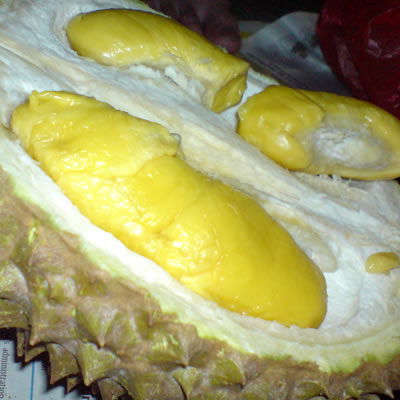
Widely known in Southeast Asia as the “king of fruits”, the durian is distinctive for its unique odour and its thorn-covered husk. Its shape ranges from oblong to round, the colour of its husk green to brown, and its flesh pale yellow to red, depending on the species.
The edible flesh emits a distinctive odour, strong and penetrating even when the husk is intact. Some people regard the durian as fragrant; while others may find the aroma offensive. The smell evokes reactions from deep appreciation to intense disgust, and has been described variously as almonds, rotten onions, turpentine and even smelly gym socks. The odour has led to the fruit’s banishment from most hotels and public transportation in Southeast Asia.
The durian, native to Brunei, Indonesia and Malaysia is a seasonal fruit, unlike some other non-seasonal tropical fruits such as the papaya, which are available throughout the year. In Peninsular Malaysia and Singapore, the durian season is typically from June to August.
Durian fruit is used to flavour a wide variety of sweet edibles such as traditional Malay candy, ice kacang, dodol, rose biscuits, and, with a touch of modern innovation, ice cream, mooncakes, and cappuccino.
Tempoyak is a popular Malay delicacy, which is durian extract, preserved and kept in a jar. It is commonly eaten with chillis and other dishes.
DODOL
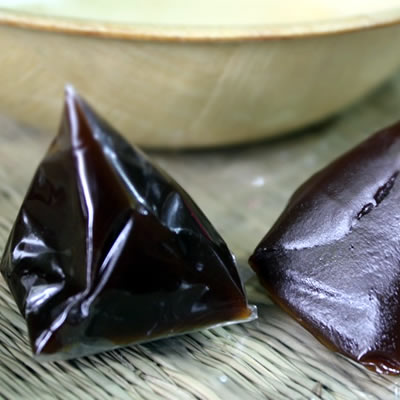
Dodol is a toffee-like sweet food delicacy popular in Indonesia and Malaysia. It is made with coconut milk, rice flour and unrefined whole-caned sugar (or commonly known as gula melaka), and is sticky, thick and sweet.
Typically, it takes up to 8–9 hours to cook dodol. During the cooking process, the dodol must be constantly stirred in a big wok, non-stop. current date time . Pausing in between would cause the dodol to burn and that will spoil the taste and aroma.
The types of dodol available are:
| • | Dodol garut: dodols produced in Garut, a regency of West Java province, Indonesia. There are many variations of dodol garut. |
| • | Dodol durian: dodol made from durian |
| • | Dodol sirsak: dodol made from soursop |
| • | Dodol nangka: dodol made from jackfruit |
| • | Dodol apel Malang: dodol made from apple, specialty of Malang city, East java. |
| • | Dodol China: Indonesian Chinese version of sweet Nian gao with rich coconut sugar |
| • | Dodol Betawi: Dodol of Betawi people, Jakarta, similar to Chinese dodol |
CORIANDER
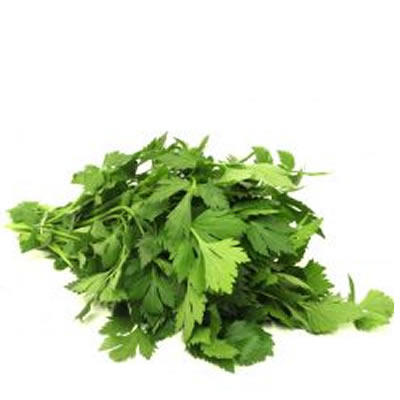
Coriander leaves, also known as cilantro, are a common ingredient in the cuisines of the Middle East, Central Asia, the Mediterranean, India, South Asia, Mexico, Texas, Latin America, China, Africa and South-East Asia. Today, it is mainly eaten as part of foreign dishes in Western Europe, even though coriander was formerly common in European cuisine.
Coriander leaves, stalks and roots have a distinctive citrusy aroma, and is used to flavour soups such as Thai tom yam, salads, Mexican salsa and guacamole, and as a garnish for dishes such as Chinese roasted meats and Indian chutneys, dhal and curries. As heat diminishes its flavour quickly, coriander is often used in raw form and added to dishes immediately before serving.
Dried and crushed coriander seeds are commonly used as a spice in both Asian and Western cuisines, and are usually described as having a warm, nutty, spicy and orange-like flavour.
As a spice, coriander is a source of antioxidants, and can be used as a natural preservative to prevent spoilage of food seasoned with it. It is also credited with having antibacterial properties, and the ability to help relieve anxiety, insomnia, indigestion and high cholesterol. In traditional medicine, it is prescribed as part of the treatment for diabetes and acne.
COCONUT
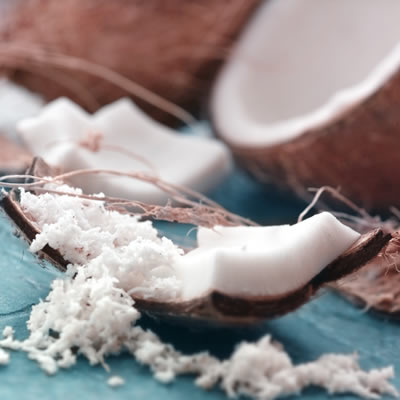
The coconut palm is so ubiquitous throughout the equatorial region that it has become an icon of the tropics in most Westerners’ minds. But the coconut is more than just a symbol of beautiful, hammock-strung tropical beaches. In fact, it provides the communities where it grows with much of the necessities of life.
Coconut water is not just a refreshing drink – it is a sterile liquid until the fruit is opened, and mixes so well with blood that it was used during World War II as an emergency transfusion liquid for patients who had lost a lot of blood.
The flesh of a young coconut is tender and sweet while the flesh from older coconuts can be dried and processed into cooking oil or grated and squeezed to extract a rich, creamy milk that’s widely used in the cuisines of South-East Asia, Brazil, Polynesia, Sri Lanka and the Caribbean.
The sap extracted from the coconut can be fermented to produce palm wine, or boiled and reduced to become palm sugar.
On top of all this, the trunk, husk, fruit and leaves can be made into a variety of materials including roofing, doormats, rope, fuel for wood-burning fires, soap, toothbrushes, cooking utensils… the list goes on and on. Truly, the coconut fully deserves its nickname in the Malay language: ‘tree of a thousand uses’.
CHOPSTICKS
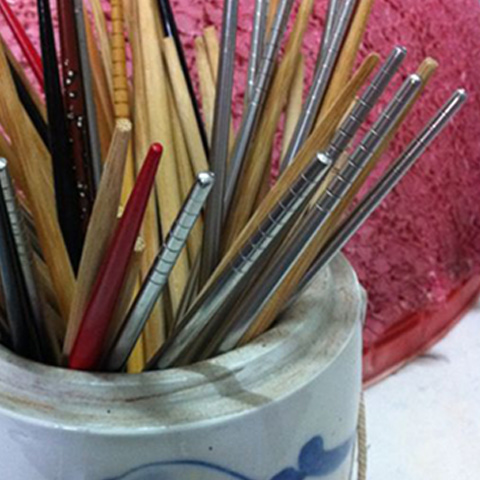
Chopsticks are typically used by Asians as an eating utensil, among the Chinese, Japanese, Korean and Vietnamese community. It is believed to have originated in ancient China.Chopsticks are short and usually tapered sticks used in pairs of equal length and commonly made of wood, bamboo, plastic, metal, bone and ivory.
Chopsticks are held in the dominant hand, between the thumb and fingers, and used to pick up pieces of food.
To use chopsticks, the lower chopstick is stationary, and rests at the base of the thumb, and between the little finger and ring finger. The second chopstick is held like a pencil, using the tips of the thumb, index finger, and middle finger, and it is moved while eating, to pull food into the grasp of the chopsticks. Chopsticks, when not in use, are placed either to the right or below one’s plate in a Chinese table setting.
In chopstick-using cultures, food is generally made into small pieces. Additionally, in traditional Chinese culture, holding the rice bowl up to the mouth and using chopsticks to transfer the rice directly into the mouth is considered proper eating etiquette.
However, it is a taboo especially among the Chinese and Japanese to stand the chopsticks on a bowl of rice as it resembles the way rice is offered to the dead.
CHINESE TEMPLE
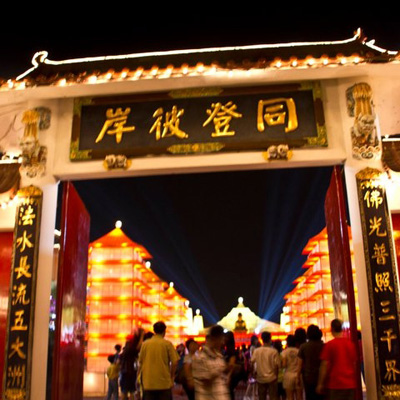
A Chinese temple can refer to any temple which is used for the practice of Chinese folk religion, a conglomeration of China’s three main religions: Buddhism, Taoism, and Confucianism.
Inside a typical temple, it is considered quite common to see elements of Buddhism and Taoism mixed together. A statue of Guan Yin may be present alongside traditionally Taoist deities such as the Jade Emperor or Mazu.
Worship in Chinese temples usually consists of making offerings to the various gods, spirits and ancestors. The main act of worship is lighting incense or joss sticks. These are generally provided to worshipers by the temple in exchange for a small donation. Worshipers generally take three or nine incense sticks and light them from an oil lamp placed beside the burner. They hold the incense sticks in both hands while bowing the head and present them as an offering to the god(s) in the temple. Larger incense sticks called joss sticks are also used in worship. Candles are also lit to the various gods. These candles are red and are made with a stick down the middle, and the stick is placed in special holders beside the incense burner, which consist of metal trays with holes in them. Larger “wish candles”, which are generally colourful and made in the shape of a flower, may also be lit, and they are usually placed on a table in front of the incense burner.
The burning of joss paper is also practiced in Chinese temples. There is a special chimney-like burner for this, either situated outside the temple or, if the temple is big enough, in the temple courtyard before the main temple.In these temples there are usually candles placed there for many special reasons.
In Malaysia, there are many well-known Chinese temples, such as Kek Lok Si in Penang, Thean Hou Temple in Kuala Lumpur, BuddhistMaha Vihara Temple in Brickfields, and Chin Swee Temple in Genting Highlands. Fascinated by its beautiful architecture, these temples are usually a not-to-be-missed destination for foreign visitors to Malaysia.
CHINESE LO HEI
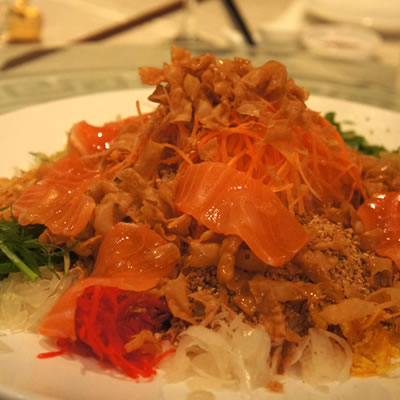
The Chinese Lo Hei also know as Yusheng, yee sang or Prosperity Toss is a Teochew-style raw fish salad. It usually consists of strips of raw fish (most commonly salmon), mixed with shredded vegetables and a variety of sauces and condiments. Yusheng literally means “raw fish” but since “fish” is commonly conflated with its homophone “abundance”, Yusheng is interpreted as a homophone for Yusheng meaning an increase in abundance. Therefore, yusheng is considered a symbol of abundance, prosperity and vigor.
Popularised in Singapore amongst the ethnic Chinese community, its consumption has been associated with Chinese New Year festivities in Singapore and Malaysia.
The Singapore-based Lo Hei had fish served with white radish, carrots, capsicum, turnips, red pickled ginger, sun-dried oranges, lime leaves, Chinese parsley, chilli, jellyfish, chopped peanuts, toasted sesame seeds, Chinese shrimp crackers, five spice powder and other ingredients, laced with a sauce using plum sauce, rice vinegar, and sesame oil.
Lo Hei is often served as the appetizer due to its symbolism of “good luck” for the new year. Some would consume it on the seventh day of the Chinese New Year, although in practice it may be eaten on any convenient day during Chinese New Year (1st to 15th Day).
The base ingredients are first served. The leader amongst the diners or the waiter proceeds to add ingredients, such as the fish, the crackers and the sauces while saying “auspicious wishes” as each ingredient is added, typically related to the specific ingredient being added. All diners at the table then stand up and proceed to toss the shredded ingredients into the air with chopsticks while saying various “auspicious wishes” out loud. It is believed that the height of the toss reflects the height of the diner’s growth in fortunes, thus diners are expected to toss enthusiastically.
CHICKPEAS
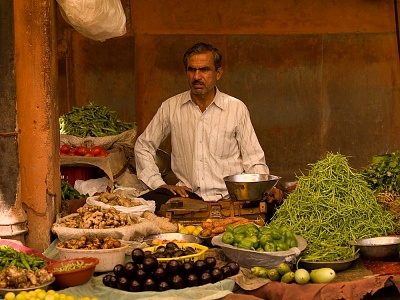
Chickpeas – roundish members of the legume family also known as garbanzo beans – are commonly associated with the popular Middle Eastern dish hummus. Grown primarily in West Asia, India and the Mediterranean, chickpeas come in two popular varieties: smaller, hard and green and larger, creamy beige.
Ground up to make flour and turned into falafel or made into Burmese tofu (vegetables and meat fried in chickpea batter), cooked down to a broth or roasted as a snack, chickpeas are extremely versatile. In India, they are used to make curries and are an extremely important ingredient in popular vegetarian dishes. In the Philippines, chickpeas are served sweet rather than savoury. The beans are preserved in syrup and eaten alone or atop popular desserts such as halo-halo.
BATU CAVES

Batu Caves is a limestone hill, which has a series of caves and cave temples, located in Gombak district, 13 kilometres north of Kuala Lumpur, Malaysia. The cave is one of the most popular Hindu shrines outside India, dedicated to Lord Murugan. It is the focal point of Hindu festival of Thaipusam in Malaysia. The procession begins in the wee hours of the morning on Thaipusam from the Sri Mahamariamman Temple, Kuala Lumpur leading up to Batu Caves as a religious undertaking to Lord Muruga lasting eight hours.
Rising almost 100 m above the ground, the Batu Caves temple complex consists of three main caves and a few smaller ones. The biggest, referred to as Cathedral Cave or Temple Cave, has a 100 m-high ceiling and features ornate Hindu shrines. To reach it, visitors must climb a steep flight of 272 steps.
At the base of the hill are two more cave temples, Art Gallery Cave and Museum Cave, both of which are full of Hindu statues and paintings. Many of the shrines relate the story of Lord Murugan’s victory over the demon Soorapadam.
The Ramayana Cave is situated to the extreme left as one faces the sheer wall of the hill. On the way to the Ramayana Cave, there is a 50-foot (15 m) tall statue of Hanuman and a temple dedicated to Hanuman, the noble monkey devotee and aide of Lord Rama.
A 42.7-metre (140 ft) high statue of Lord Muruga was unveiled in January 2006, having taken 3 years to construct. It is the tallest Lord Muruga statue in the world.
BAMBOO STEAMERS
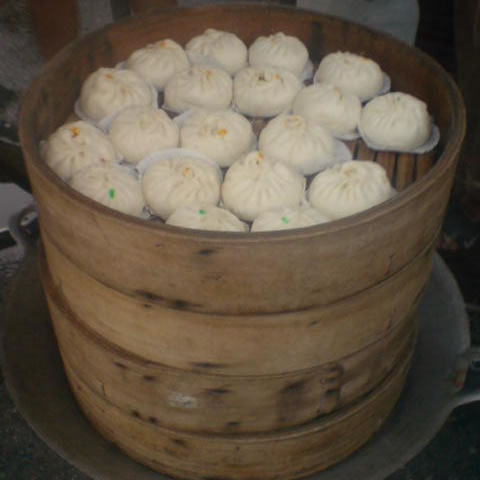
Bamboo steamers are popularly used among the Chinese community as part of their cooking utensils. It can be stacked on top of each other so that the steam can cook many different servings simultaneously.
Bamboo steamers is said to be unique as it is designed to produce a more flavorful, evenly cooked meal, at the same time maintaining the natural characteristics of the food as well as preserving essential vitamins and minerals that could otherwise be lost by other cooking methods, such as boiling, frying, or sautéeing.
Bamboo steamers come in a variety of sizes, and are traditionally constructed of a circular frame, with a slotted bottom and a domed lid. The lid and slotted bottom work together effectively to keep steam trapped and free-flowing throughout the steamer. The bamboo helps to absorb excess moisture and retains heat.
The steamer itself is designed to fit neatly within a wok. The wok should be filled with water until just below the bottom of the bamboo. You can place the food directly upon the slots. The water is put to boil and cover tightly with the lid, then simply wait the appropriate time for the food to be done.
BAK KWA
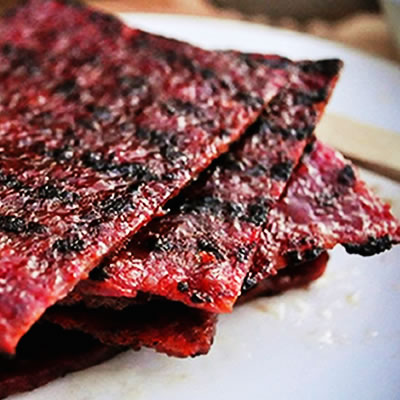
Bakkwa is a Chinese salty-sweet dried meat, made in the form of flat thin sheets. It is normally made from pork. Compgutgiudabte . However, there is now a chicken alternative to pork bakkwa. expired domains . Bakkwa is believed to have originated from a meat preservation and preparation technique used in ancient China that is still practiced in places with Hokkien influence.
In Malaysia, Singapore, Riau Islands and the Philippines bakkwa or bagua is the most widely used name. Cantonese speakers use the term yuhk gōn, Anglicised versionlong yok, while in China and Taiwan the product is more commonly known as rougan. Commercially available versions are sometimes labeled as “barbecued pork”, “dried pork”, or “pork jerky”. Bakkwa is particularly popular as a snack in East Asia and Southeast Asia.
In Malaysia and Singapore, bakkwa has become a highly popular gift offered to visitors and acquaintances during the Chinese New Year. While demand is particularly high during the festive seasons, it is also served throughout the year in various outlets as takeaway snacks. The meat is commonly sold in red-coloured packaging, an auspicious colour in Chinese culture.
BAK KUT TEH
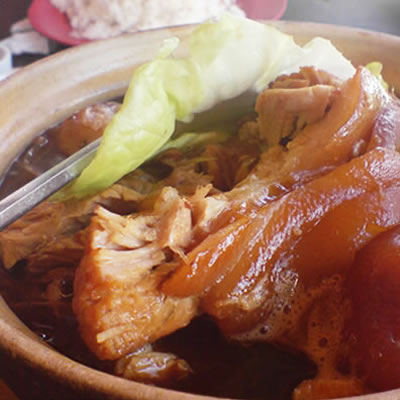
Bak kut teh is a Chinese soup popularly served in Malaysia, Singapore, China and Taiwan.
The name literally translates as “meat bone tea”, and, at its simplest, consists of meaty pork ribs simmered in a broth of herbs and spices (including star anise, cinnamon, cloves, dang gui, fennel seeds and garlic). However, additional ingredients may include offal, varieties of mushroom, choy sum, and pieces of dried tofu or fried tofu puffs. oort cloud Light and dark soy sauce are also added to the soup during cooking, with varying amounts depending on the variant. Garnishings include chopped coriander or green onions and a sprinkling of fried shallots.
Bak kut teh is usually eaten with rice and often served with youtiao / cha kueh [yau char kwai] (strips of fried dough) for dipping into the soup. Soy sauce (usually light soy sauce) is preferred as a condiment, with which chopped chilli padi and minced garlic is taken together. Chinese tea of various kinds is also usually served in the belief that it dilutes or dissolves the amount of fat consumed in this pork-laden dish.Bak kut teh is typically a famous morning meal.
ARROW HEAD
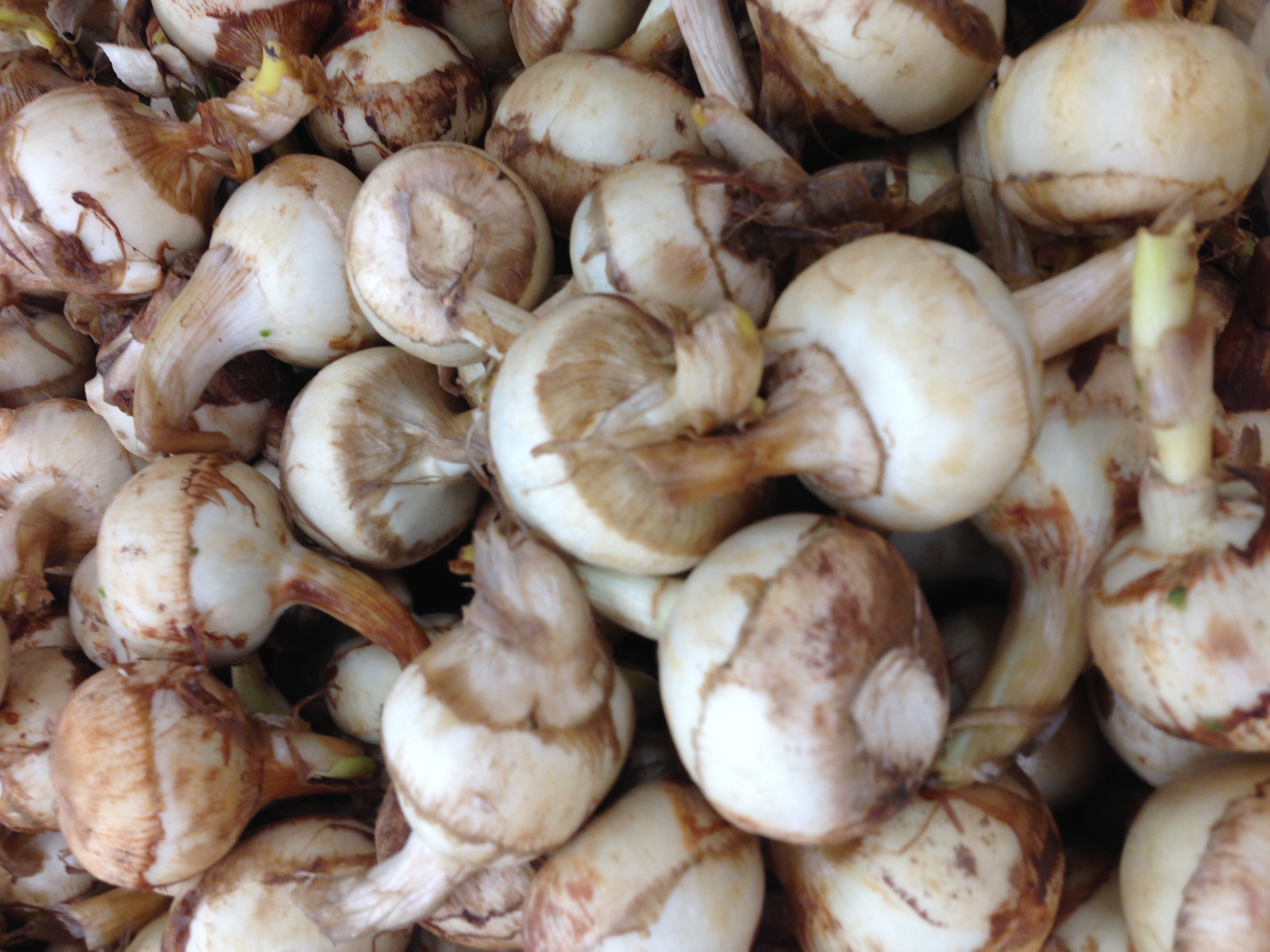
Arrow head has bulb-like corms which are native to China and Japan where it is largely cultivated.
Raw arrowhead has a slight bitter taste. Gudisertomu . It is simply prepared by steaming the peeled raw arrowhead with Chinese sausage. The waxy flavor and fats of the Chinese sausage will mask the bitter taste making it a delectable dish enjoys by both the young and old.
Innovative cooks have turned these bland starchy arrowheads into tasty and addictive chips better known as ngaku. Ngaku are easily prepared just by slicing the corm thinly directly into hot oil making them crispy. domain analysis These chips are only available in Malaysia during Chinese New Year. Jars of ngaku are widely sold throughout Malaysia in the weeks leading up to the festival season.
APAM BALIK
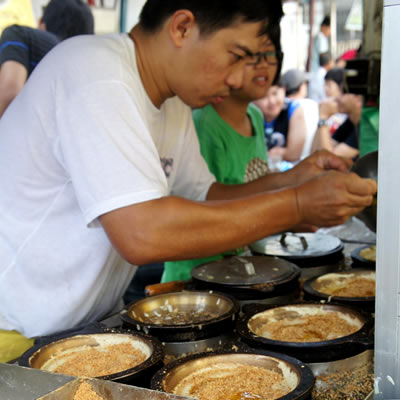
Apam Balik is one of the local traditional delicacies, made popular as a street food in Malaysia and Singapore . Among the Chinese, it is usually referred to as Ban Chien Kuieh. It is basically a sweet pancake heated on a hot pan and lazed with a rich layer of butter, and filled with peanuts and corns and folded into two. internet use statistics This delicious pancake with its crispy crust, roasted peanut, sugar crumb and corn stuffing is best to be eaten while it’s hot. The batter is made from flour, eggs, sugar, yeast and water so it’s actually thicker than a crepe, but not as fluffy as a pancake.
Typically there are two types of Apam. The traditional Apam Balik refers to the thicker pancake, cooked on a massive pancake griddle. These traditional Apam Balik is typically cut into 11 or 12 individual portions. Then there is the small Apam Balik which is the thin crepe version which is prepared on a smaller pan. These days, Apam Balik is widely sold in pasar malam or night markets. The batter is scooped from a container and poured onto the pan and the street vendor would use the bottom of the cup to even out the batter onto the pan.
AIS KACANG
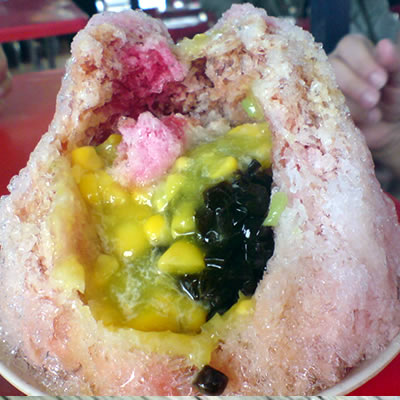
Ais Kacang, also known as air batu campur. In the Malay language, “ais batu” simply means “ice”. Traditionally a special ice machine is used to churn out the shaved ice used in the dessert, originally hand cranked but now more often motorized.
Today, ice kacang generally comes in bright colours, and with different fruit cocktails and dressings. In Malaysia, almost all variants now contain a large serving of attap chee (palm seed), red beans, sweet corn, grass jelly (cincau) and cubes of agar agar as common ingredients. Evaporated milk or condensed milk are used to top the ice and dressings, along with red rose syrup.
Many South-East Asian coffee shops, food courts and street hawkers offer this dessert. Nowdays, Ais Kacang is mostly known as ‘ABC’.
Privacy
Pledge on Privacy
The term “personal information” as used in this Privacy statement refers to information from which your identity can reasonably be ascertained. WORLDFOODS® developed this Privacy statement to provide information about our practices regarding the collection, use, and disclosure of information that you may provide when you visit this Site. We encourage you to read this before using this Site or submitting information. By using this Site, you acknowledge that you understand and agree to the terms of the Privacy statement.
Collection and Use of Personal Information
WORLDFOODS® processes personal information for specific and limited purposes which we inform you about when we ask you for information. For example, we may collect and use personal data to market products and services which we think may be of interest to you, or to communicate with you for other purposes. Information you send to our customer service department is used only to help resolve your problem and is otherwise kept private. WORLDFOODS® keeps your data only for as long as is reasonably needed for such purposes and in accordance with any applicable legal reporting or documentation retention requirements.
We only collect personal information from you when you visit the Site if you sign up to be a member of the Site or use the “World Platter” facility. We may also use this information to send you by e-mail certain product or other information which we consider to be of importance to you but will give you the opportunity to tell us if you do not want to receive this information.
Disclosure of Information
We will not share with third parties any data about you that is sensitive in the absence of your prior and explicit consent. Your consent may always be revoked at a later date. If consent is revoked WORLDFOODS® may not be able to carry out certain requests made by you. WORLDFOODS® will not sell or rent your personally identifiable information.
WORLDFOODS® will not treat as confidential any information that you provide that is not personally identifiable, such as questions, comments, ideas, or suggestions. You should be aware that WORLDFOODS® will be free to disclose through any means and use for any purpose such information in its sole discretion. By providing such information to WORLDFOODS®, you understand and agree that no relationship has been created between WORLDFOODS® and you, and WORLDFOODS® has no obligation to you whatsoever regarding that information.
Right of Access
You have the right to access and update your personal information. We take reasonable steps to ensure that personal information we hold is up-to-date, accurate, and complete.
Security and Confidentiality
WORLDFOODS® takes reasonable steps to ensure the security and confidentiality of personal information that it collects on-line. WORLDFOODS® uses data networks protected, inter alia, by firewall and password protection. Access to personal information is restricted to those employees who have a need to use the data, who have been trained to handle such data properly and observe strict standards of confidentiality. If an employee breaches our policies and procedures he/she will be disciplined accordingly. Staff compliance with our policies and procedures is regularly audited and reviewed. While we cannot guarantee against any loss, misuse or alteration to data, we try to prevent such unfortunate occurrences.
Anonymous Data and “Cookies”
Most of the information that WORLDFOODS® collects when you visit the Site is anonymous information, such as the pages you visit and searches you perform, which is processed by WORLDFOODS® to help improve the contents of the Site and to compile aggregate statistics about use of the Site for internal, market research purposes. To collect this anonymous information, “cookies” may be sent via your browser and installed on your hard drive that collect the first level domain name of the user (e.g., “bigmail.com” from an e-mail address of “john@bigmail.com”) and the date and time of access. “Cookies” by themselves cannot be used to discover the identity of the user. A “cookie” is a small piece of information which is sent to your browser and stored on your computer’s hard drive. You can set your browser to notify you when you receive a “cookie”, this will enable you to decide if you want to accept it or not.
Spamming
WORLDFOODS® does not condone “spamming”. Spamming is defined as sending unsolicited e-mails, usually of a commercial nature, in large numbers and repeatedly to individuals with whom the sender has had no previous contact or who have declined to receive such communications. If you contact us by email and WORLDFOODS® believes that certain product or other information is of importance to you, we may inform you by e-mail but will give you the choice to opt out of receiving further communications of this type.
Personal Information and Children
WORLDFOODS® will not knowingly collect, use or disclose personal information from a minor under the age of 13, without obtaining prior consent from a person with parental responsibility (e.g., a parent or guardian) through direct off-line contact. We will provide the parent with (i) notice of the specific types of personal information being collected from the minor, and (ii) the opportunity to object to any further collection, use, or storage of such information.
Links to Other Sites
This Privacy statement applies only to the Site. Other websites operated by WORLDFOODS® entities outside the country may have their own Privacy statement. If you link from the Site to another website operated by a third party any personal information collected, used or disclosed as a result of your accessing that website will be subject to the relevant operator’s privacy policy and any privacy laws which apply to that operator.
Terms & Conditions
Your access to and use of www.worldplatter.com (the “Site”) is subject to the following terms and conditions. By accessing and browsing the Site, you accept, without limitation or qualification, these Terms of use and acknowledge that any other agreements between you and us, WORLDFOODS®, affecting the matters dealt with in these Terms and Conditions are superseded and of no force or effect. In addition, when you use any current or future www.worldplatter.com service, you also will be subject to the guidelines and conditions applicable to such service or business.
You may download, display or print information from the Site (the “Information”) solely for non-commercial personal use.
You must retain and reproduce each and every copyright notice or other proprietary rights notice contained in any Information you download. You may not, however, distribute, modify, transmit, reuse, repost, or use the content of the Site for public or commercial purposes, including any text, images, audio, and video content, logos, button icons, digital downloads, data compilations and software without written permission of WORLDFOODS®. You should assume that everything you see or read on the Site is subject to copyright unless otherwise noted and may not be used except as provided in these Terms and Conditions or in the text on the Site without the written permission of WORLDFOODS®. WORLDFOODS® neither warrants nor represents that your use of materials displayed on the Site will not infringe rights of third parties not owned by or affiliated with WORLDFOODS®.
With the exception of the limited authorisation set out in paragraph 1, no license to or right in any copyright of WORLDFOODS® or of any other party with respect to material on the Site is granted to or conferred to you.
The Site may contain or reference trademarks, patents, proprietary information, technologies, products, processes or other proprietary rights of WORLDFOODS®s, its affiliates and/or other parties. No license to or right in any such trademarks, patents, trade secrets, technologies, products, processes and other proprietary rights of WORLDFOODS®, its affiliates and/or other parties is granted to or conferred upon you.
While WORLDFOODS® uses reasonable efforts to ensure the Information is accurate and up to date, WORLDFOODS® makes no warranties or representations with respect to the Site or the Information, which is provided “as is”. To the extent permitted by law, WORLDFOODS® accepts no responsibility or liability whatsoever arising from or in any way connected with the use of the Site or the Information. To the extent permitted by law, WORLDFOODS® will not be liable for the accuracy, completeness, adequacy, timeliness, or comprehensiveness of the Information and assumes no responsibility, and shall not be liable for, any loss, cost or damage you may suffer or incur as a result of your reliance on any Information or your use or inability to use or access the Site, including (without limitation) loss cost or damage resulting from viruses that may infect your computer equipment or other property as a result of your access to, use of, or browsing in the Site or your downloading of any materials, data, text, images, video, or audio from the Site. WORLDFOODS® reserves the right without notice to interrupt or discontinue any or all of the functionalities of the Site. To the extent permitted by law, WORLDFOODS® accepts no responsibility or liability whatsoever for any interruption or discontinuance of any or all functionalities of the Site.
Any communication or material you transmit to the Site by electronic mail or otherwise, including any data, questions, comments, suggestions or the like is, and subject to our obligations under applicable privacy laws with regard to personal information will be treated as, nonconfidential and nonproprietary. Anything you transmit or post becomes the property of WORLDFOODS® or its affiliates and (with the exception of personal information, which will be handled in accordance with our Privacy statement) may be used for any purpose, including, but not limited to, reproduction, disclosure, transmission, publication, broadcast and posting. Furthermore, WORLDFOODS® is free to use any ideas, concepts, know-how, or techniques contained in any communication you send to the Site for any purpose whatsoever including, but not limited to, developing, manufacturing and marketing products using such information.
The Information may contain technical inaccuracies or typographical errors. WORLDFOODS® reserves the right to make changes, corrections and/or improvements to the Information, and to the products and programs described in such information, at any time without notice.
The Site may contain information or links to other sites containing information on WORLDFOODS® products and services, not all of which are available in every location. A reference to a WORLDFOODS® product or service on a WORLDFOODS® website (including the Site) does not imply that such product or service is or will be available in your country.
Because WORLDFOODS® has no control over and does not endorse any of the sites to which the Site is linked, you acknowledge that WORLDFOODS® is not responsible for the content of any off-site pages or any other sites linked to the Site. Your linking to off-site pages or other sites is at your own risk and may be subject to terms and conditions or other legal statements and privacy policies for those pages or sites.
You are prohibited from posting or transmitting any unlawful, threatening, libellous, defamatory, obscene, scandalous, inflammatory, pornographic, or profane material or any material that could constitute or encourage conduct that would be considered a criminal offence, give rise to civil liability, or otherwise violate any law. WORLDFOODS® will fully cooperate with any law enforcement authorities or court order requesting or directing WORLDFOODS® to disclose the identity of anyone posting any such information or materials. You may not use a false e-mail address, impersonate any person or entity, or otherwise mislead as to the origin of your content. WORLDFOODS® reserves the right (but not the obligation) to remove or edit such content, but does not regularly review posted content.
WORLDFOODS®s may at any time revise these Terms and Conditions and its Privacy statement by updating this posting. You are bound by any such revisions and should periodically visit this page to review the current Terms and Conditions and Privacy statement.
When you visit www.worldplatter.com or send e-mails to us, you are communicating with us electronically. You consent to receive communications from us electronically. We will communicate with you by e-mail or by posting notices on this site. You agree that all agreements, notices, disclosures and other communications that we provide to you electronically satisfy any legal requirement that such communications be in writing.
If you have registered with www.worldplatter.com, you are responsible for maintaining the confidentiality of log-in information and for restricting access to your computer, and you agree to accept responsibility for all activities that occur under your account or password.
While we encourage freedom of speech and expression in this community, all opinions expressed in blogs, comments and discussions are solely those of the individual participants and do not represent the opinion of WORLDFOODS®.